
EAGLE
Eagle Family: Exploring Model Designs, Data Recipes and Training Strategies for Frontier-Class Multimodal LLMs
Stars: 646
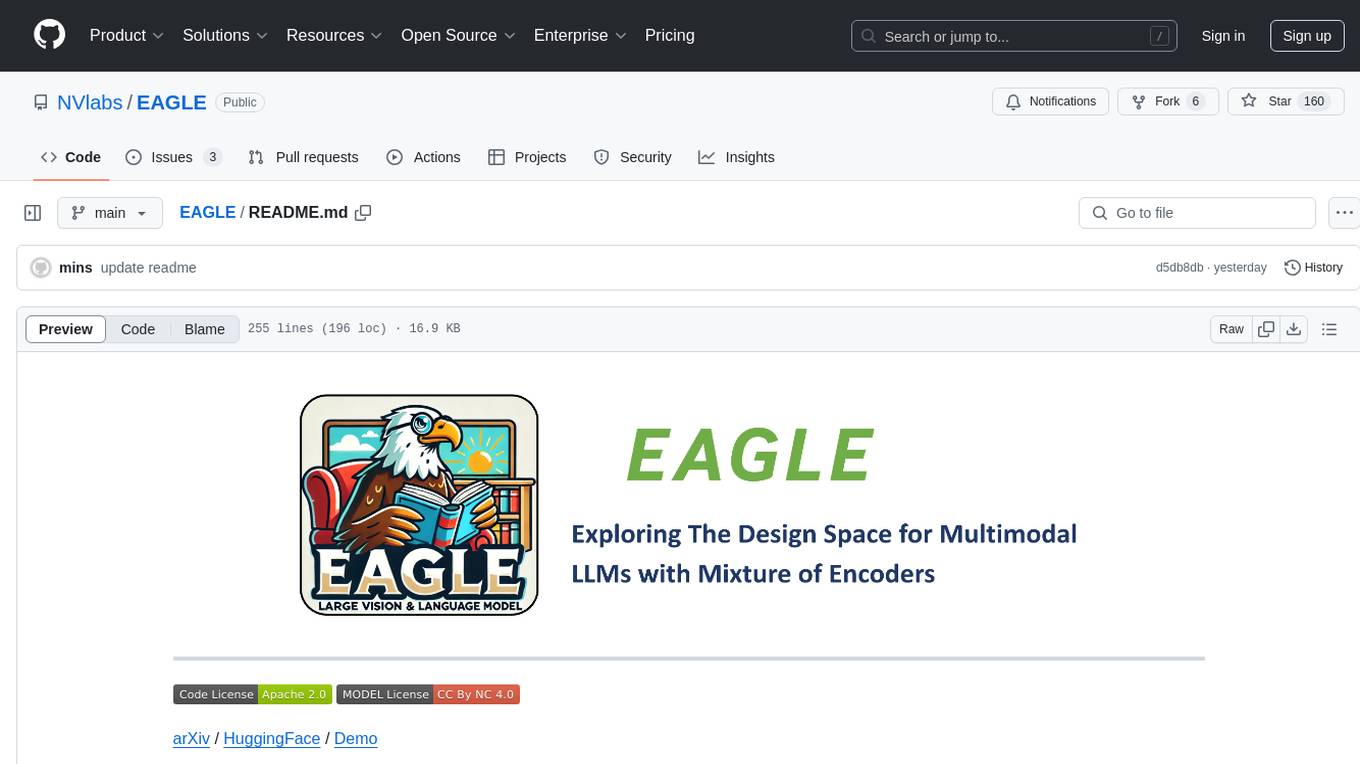
Eagle is a family of Vision-Centric High-Resolution Multimodal LLMs that enhance multimodal LLM perception using a mix of vision encoders and various input resolutions. The model features a channel-concatenation-based fusion for vision experts with different architectures and knowledge, supporting up to over 1K input resolution. It excels in resolution-sensitive tasks like optical character recognition and document understanding.
README:
[📜 Eagle2 Paper] [📜 Eagle1 Paper] [🤗 HF Models] [🗨️ Demo]
We are thrilled to release our latest Eagle2 series Vision-Language Model. Open-source Vision-Language Models (VLMs) have made significant strides in narrowing the gap with proprietary models. However, critical details about data strategies and implementation are often missing, limiting reproducibility and innovation. In this project, we focus on VLM post-training from a data-centric perspective, sharing insights into building effective data strategies from scratch. By combining these strategies with robust training recipes and model design, we introduce Eagle2, a family of performant VLMs. Our work aims to empower the open-source community to develop competitive VLMs with transparent processes.
- [2025/01] 🔥 Release Eagle-2 (WIP)
- [2025/01] 🔥 Eagle-1 is accepted by ICLR 2025.
- [2024/08] Release Eagle-1.
We provide the following models:
| model name | LLM | Vision | Max Length | HF Link |
|---|---|---|---|---|
| Eagle2-1B | Qwen2.5-0.5B-Instruct | Siglip | 16K | 🤗 link |
| Eagle2-2B | Qwen2.5-1.5B-Instruct | Siglip | 16K | 🤗 link |
| Eagle2-9B | Qwen2.5-7B-Instruct | Siglip+ConvNext | 16K | 🤗 link |
Eagle2-1B Results
| Benchmark | LLaVa-One-Vision-0.5B | InternVL2-1B | InternVL2.5-1B | Qwen2-VL-2B | Eagle2-1B |
|---|---|---|---|---|---|
| DocVQAtest | 70.0 | 81.7 | 84.8 | 90.1 | 81.8 |
| ChartQAtest | 61.4 | 72.9 | 75.9 | 73.0 | 77.0 |
| InfoVQAtest | 41.8 | 50.9 | 56.0 | 65.5 | 54.8 |
| TextVQAval | - | 70.0 | 72.0 | 79.7 | 76.6 |
| OCRBench | 565 | 754 | 785 | 809 | 767 |
| MMEsum | 1438.0 | 1794.4 | 1950.5 | 1872.0 | 1790.2 |
| RealWorldQA | 55.6 | 50.3 | 57.5 | 62.6 | 55.4 |
| AI2Dtest | 57.1 | 64.1 | 69.3 | 74.7 | 70.9 |
| MMMUval | 31.4 | 36.7 | 40.9 | 41.1 | 38.8 |
| MMVetGPT-4-Turbo | 32.2 | 32.7 | 48.8 | 49.5 | 40.9 |
| MathVistatestmini | 33.8 | 37.7 | 43.2 | 43.0 | 45.3 |
| MMstar | 37.7 | 45.7 | 50.1 | 48.0 | 48.5 |
Eagle2-2B Results
| Benchmark | InternVL2-2B | InternVL2.5-2B | InternVL2-4B | Qwen2-VL-2B | Eagle2-2B |
|---|---|---|---|---|---|
| DocVQAtest | 86.9 | 88.7 | 89.2 | 90.1 | 88.0 |
| ChartQAtest | 76.2 | 79.2 | 81.5 | 73.0 | 82.0 |
| InfoVQAtest | 58.9 | 60.9 | 67.0 | 65.5 | 65.8 |
| TextVQAval | 73.4 | 74.3 | 74.4 | 79.7 | 79.1 |
| OCRBench | 784 | 804 | 788 | 809 | 818 |
| MMEsum | 1876.8 | 2138.2 | 2059.8 | 1872.0 | 2109.8 |
| RealWorldQA | 57.3 | 60.1 | 60.7 | 62.6 | 63.1 |
| AI2Dtest | 74.1 | 74.9 | 74.7 | 78.9 | 79.3 |
| MMMUval | 36.3 | 43.6 | 47.9 | 41.1 | 43.1 |
| MMVetGPT-4-Turbo | 39.5 | 60.8 | 51.0 | 49.5 | 53.8 |
| HallBenchavg | 37.9 | 42.6 | 41.9 | 41.7 | 45.8 |
| MathVistatestmini | 46.3 | 51.3 | 58.6 | 43.0 | 54.7 |
| MMstar | 50.1 | 53.7 | 54.3 | 48.0 | 56.4 |
| Benchmark | MiniCPM-Llama3-V-2_5 | InternVL-Chat-V1-5 | InternVL2-8B | QwenVL2-7B | Eagle2-9B |
|---|---|---|---|---|---|
| Model Size | 8.5B | 25.5B | 8.1B | 8.3B | 8.9B |
| DocVQAtest | 84.8 | 90.9 | 91.6 | 94.5 | 92.6 |
| ChartQAtest | - | 83.8 | 83.3 | 83.0 | 86.4 |
| InfoVQAtest | - | 72.5 | 74.8 | 74.3 | 77.2 |
| TextVQAval | 76.6 | 80.6 | 77.4 | 84.3 | 83.0 |
| OCRBench | 725 | 724 | 794 | 845 | 868 |
| MMEsum | 2024.6 | 2187.8 | 2210.3 | 2326.8 | 2260 |
| RealWorldQA | 63.5 | 66.0 | 64.4 | 70.1 | 69.3 |
| AI2Dtest | 78.4 | 80.7 | 83.8 | - | 83.9 |
| MMMUval | 45.8 | 45.2 / 46.8 | 49.3 / 51.8 | 54.1 | 56.1 |
| MMBench_V11test | 79.5 | 79.4 | 80.6 | ||
| MMVetGPT-4-Turbo | 52.8 | 55.4 | 54.2 | 62.0 | 62.2 |
| SEED-Image | 72.3 | 76.0 | 76.2 | 77.1 | |
| HallBenchavg | 42.4 | 49.3 | 45.2 | 50.6 | 49.3 |
| MathVistatestmini | 54.3 | 53.5 | 58.3 | 58.2 | 63.8 |
| MMstar | - | - | 60.9 | 60.7 | 62.6 |
We provide a local chat demo powered by Streamlit to help users get started with Eagle2 quickly and easily.
This demo is built upon InternVL's template and extends it with additional video input support for enhanced functionality.
We provide a inference script to help you quickly start using the model. We support different input types:
- pure text input
- single image input
- multiple image input
- video input
pip install transformers==4.37.2
pip install flash-attnNote: Latest version of transformers is not compatible with the model.
Click to expand
"""
A model worker executes the model.
Copied and modified from https://github.com/OpenGVLab/InternVL/blob/main/streamlit_demo/model_worker.py
"""
# Importing torch before transformers can cause `segmentation fault`
from transformers import AutoModel, AutoTokenizer, TextIteratorStreamer, AutoConfig
import argparse
import base64
import json
import os
import decord
import threading
import time
from io import BytesIO
from threading import Thread
import math
import requests
import torch
import torchvision.transforms as T
from PIL import Image
from torchvision.transforms.functional import InterpolationMode
import numpy as np
IMAGENET_MEAN = (0.485, 0.456, 0.406)
IMAGENET_STD = (0.229, 0.224, 0.225)
SIGLIP_MEAN = (0.5, 0.5, 0.5)
SIGLIP_STD = (0.5, 0.5, 0.5)
def get_seq_frames(total_num_frames, desired_num_frames=-1, stride=-1):
"""
Calculate the indices of frames to extract from a video.
Parameters:
total_num_frames (int): Total number of frames in the video.
desired_num_frames (int): Desired number of frames to extract.
Returns:
list: List of indices of frames to extract.
"""
assert desired_num_frames > 0 or stride > 0 and not (desired_num_frames > 0 and stride > 0)
if stride > 0:
return list(range(0, total_num_frames, stride))
# Calculate the size of each segment from which a frame will be extracted
seg_size = float(total_num_frames - 1) / desired_num_frames
seq = []
for i in range(desired_num_frames):
# Calculate the start and end indices of each segment
start = int(np.round(seg_size * i))
end = int(np.round(seg_size * (i + 1)))
# Append the middle index of the segment to the list
seq.append((start + end) // 2)
return seq
def build_video_prompt(meta_list, num_frames, time_position=False):
# if time_position is True, the frame_timestamp is used.
# 1. pass time_position, 2. use env TIME_POSITION
time_position = os.environ.get("TIME_POSITION", time_position)
prefix = f"This is a video:\n"
for i in range(num_frames):
if time_position:
frame_txt = f"Frame {i+1} sampled at {meta_list[i]:.2f} seconds: <image>\n"
else:
frame_txt = f"Frame {i+1}: <image>\n"
prefix += frame_txt
return prefix
def load_video(video_path, num_frames=64, frame_cache_root=None):
if isinstance(video_path, str):
video = decord.VideoReader(video_path)
elif isinstance(video_path, dict):
assert False, 'we not support vidoe: "video_path" as input'
fps = video.get_avg_fps()
sampled_frames = get_seq_frames(len(video), num_frames)
samepld_timestamps = [i / fps for i in sampled_frames]
frames = video.get_batch(sampled_frames).asnumpy()
images = [Image.fromarray(frame) for frame in frames]
return images, build_video_prompt(samepld_timestamps, len(images), time_position=True)
def load_image(image):
if isinstance(image, str) and os.path.exists(image):
return Image.open(image)
elif isinstance(image, dict):
if 'disk_path' in image:
return Image.open(image['disk_path'])
elif 'base64' in image:
return Image.open(BytesIO(base64.b64decode(image['base64'])))
elif 'url' in image:
response = requests.get(image['url'])
return Image.open(BytesIO(response.content))
elif 'bytes' in image:
return Image.open(BytesIO(image['bytes']))
else:
raise ValueError(f'Invalid image: {image}')
else:
raise ValueError(f'Invalid image: {image}')
def build_transform(input_size, norm_type='imagenet'):
if norm_type == 'imagenet':
MEAN, STD = IMAGENET_MEAN, IMAGENET_STD
elif norm_type == 'siglip':
MEAN, STD = SIGLIP_MEAN, SIGLIP_STD
transform = T.Compose([
T.Lambda(lambda img: img.convert('RGB') if img.mode != 'RGB' else img),
T.Resize((input_size, input_size), interpolation=InterpolationMode.BICUBIC),
T.ToTensor(),
T.Normalize(mean=MEAN, std=STD)
])
return transform
def find_closest_aspect_ratio(aspect_ratio, target_ratios, width, height, image_size):
"""
previous version mainly foucs on ratio.
We also consider area ratio here.
"""
best_factor = float('-inf')
best_ratio = (1, 1)
area = width * height
for ratio in target_ratios:
target_aspect_ratio = ratio[0] / ratio[1]
ratio_diff = abs(aspect_ratio - target_aspect_ratio)
area_ratio = (ratio[0]*ratio[1]*image_size*image_size)/ area
"""
new area > 60% of original image area is enough.
"""
factor_based_on_area_n_ratio = min((ratio[0]*ratio[1]*image_size*image_size)/ area, 0.6)* \
min(target_aspect_ratio/aspect_ratio, aspect_ratio/target_aspect_ratio)
if factor_based_on_area_n_ratio > best_factor:
best_factor = factor_based_on_area_n_ratio
best_ratio = ratio
return best_ratio
def dynamic_preprocess(image, min_num=1, max_num=6, image_size=448, use_thumbnail=False):
orig_width, orig_height = image.size
aspect_ratio = orig_width / orig_height
# calculate the existing image aspect ratio
target_ratios = set(
(i, j) for n in range(min_num, max_num + 1) for i in range(1, n + 1) for j in range(1, n + 1) if
i * j <= max_num and i * j >= min_num)
target_ratios = sorted(target_ratios, key=lambda x: x[0] * x[1])
# find the closest aspect ratio to the target
target_aspect_ratio = find_closest_aspect_ratio(
aspect_ratio, target_ratios, orig_width, orig_height, image_size)
# calculate the target width and height
target_width = image_size * target_aspect_ratio[0]
target_height = image_size * target_aspect_ratio[1]
blocks = target_aspect_ratio[0] * target_aspect_ratio[1]
# resize the image
resized_img = image.resize((target_width, target_height))
processed_images = []
for i in range(blocks):
box = (
(i % (target_width // image_size)) * image_size,
(i // (target_width // image_size)) * image_size,
((i % (target_width // image_size)) + 1) * image_size,
((i // (target_width // image_size)) + 1) * image_size
)
# split the image
split_img = resized_img.crop(box)
processed_images.append(split_img)
assert len(processed_images) == blocks
if use_thumbnail and len(processed_images) != 1:
thumbnail_img = image.resize((image_size, image_size))
processed_images.append(thumbnail_img)
return processed_images
def split_model(model_path, device):
device_map = {}
world_size = torch.cuda.device_count()
config = AutoConfig.from_pretrained(model_path, trust_remote_code=True)
num_layers = config.llm_config.num_hidden_layers
print('world_size', world_size)
num_layers_per_gpu_ = math.floor(num_layers / (world_size - 1))
num_layers_per_gpu = [num_layers_per_gpu_] * world_size
num_layers_per_gpu[device] = num_layers - num_layers_per_gpu_ * (world_size-1)
print(num_layers_per_gpu)
layer_cnt = 0
for i, num_layer in enumerate(num_layers_per_gpu):
for j in range(num_layer):
device_map[f'language_model.model.layers.{layer_cnt}'] = i
layer_cnt += 1
device_map['vision_model'] = device
device_map['mlp1'] = device
device_map['language_model.model.tok_embeddings'] = device
device_map['language_model.model.embed_tokens'] = device
device_map['language_model.output'] = device
device_map['language_model.model.norm'] = device
device_map['language_model.lm_head'] = device
device_map['language_model.model.rotary_emb'] = device
device_map[f'language_model.model.layers.{num_layers - 1}'] = device
return device_map
class ModelWorker:
def __init__(self, model_path, model_name,
load_8bit, device):
if model_path.endswith('/'):
model_path = model_path[:-1]
if model_name is None:
model_paths = model_path.split('/')
if model_paths[-1].startswith('checkpoint-'):
self.model_name = model_paths[-2] + '_' + model_paths[-1]
else:
self.model_name = model_paths[-1]
else:
self.model_name = model_name
print(f'Loading the model {self.model_name}')
tokenizer = AutoTokenizer.from_pretrained(model_path, trust_remote_code=True, use_fast=False)
tokens_to_keep = ['<box>', '</box>', '<ref>', '</ref>']
tokenizer.additional_special_tokens = [item for item in tokenizer.additional_special_tokens if item not in tokens_to_keep]
self.tokenizer = tokenizer
config = AutoConfig.from_pretrained(model_path, trust_remote_code=True)
model_type = config.vision_config.model_type
self.device = torch.cuda.current_device()
if model_type == 'siglip_vision_model':
self.norm_type = 'siglip'
elif model_type == 'MOB':
self.norm_type = 'siglip'
else:
self.norm_type = 'imagenet'
if any(x in model_path.lower() for x in ['34b']):
device_map = split_model(model_path, self.device)
else:
device_map = None
if device_map is not None:
self.model = AutoModel.from_pretrained(model_path, torch_dtype=torch.bfloat16,
low_cpu_mem_usage=True,
device_map=device_map,
trust_remote_code=True,
load_in_8bit=load_8bit).eval()
else:
self.model = AutoModel.from_pretrained(model_path, torch_dtype=torch.bfloat16,
trust_remote_code=True,
load_in_8bit=load_8bit).eval()
if not load_8bit and device_map is None:
self.model = self.model.to(device)
self.load_8bit = load_8bit
self.model_path = model_path
self.image_size = self.model.config.force_image_size
self.context_len = tokenizer.model_max_length
self.per_tile_len = 256
def reload_model(self):
del self.model
torch.cuda.empty_cache()
if self.device == 'auto':
os.environ['CUDA_LAUNCH_BLOCKING'] = '1'
# This can make distributed deployment work properly
self.model = AutoModel.from_pretrained(
self.model_path,
load_in_8bit=self.load_8bit,
torch_dtype=torch.bfloat16,
device_map=self.device_map,
trust_remote_code=True).eval()
else:
self.model = AutoModel.from_pretrained(
self.model_path,
load_in_8bit=self.load_8bit,
torch_dtype=torch.bfloat16,
trust_remote_code=True).eval()
if not self.load_8bit and not self.device == 'auto':
self.model = self.model.cuda()
@torch.inference_mode()
def generate(self, params):
system_message = params['prompt'][0]['content']
send_messages = params['prompt'][1:]
max_input_tiles = params['max_input_tiles']
temperature = params['temperature']
top_p = params['top_p']
max_new_tokens = params['max_new_tokens']
repetition_penalty = params['repetition_penalty']
video_frame_num = params.get('video_frame_num', 64)
do_sample = True if temperature > 0.0 else False
global_image_cnt = 0
history, pil_images, max_input_tile_list = [], [], []
for message in send_messages:
if message['role'] == 'user':
prefix = ''
if 'image' in message:
for image_data in message['image']:
pil_images.append(load_image(image_data))
prefix = prefix + f'<image {global_image_cnt + 1}><image>\n'
global_image_cnt += 1
max_input_tile_list.append(max_input_tiles)
if 'video' in message:
for video_data in message['video']:
video_frames, tmp_prefix = load_video(video_data, num_frames=video_frame_num)
pil_images.extend(video_frames)
prefix = prefix + tmp_prefix
global_image_cnt += len(video_frames)
max_input_tile_list.extend([1] * len(video_frames))
content = prefix + message['content']
history.append([content, ])
else:
history[-1].append(message['content'])
question, history = history[-1][0], history[:-1]
if global_image_cnt == 1:
question = question.replace('<image 1><image>\n', '<image>\n')
history = [[item[0].replace('<image 1><image>\n', '<image>\n'), item[1]] for item in history]
try:
assert len(max_input_tile_list) == len(pil_images), 'The number of max_input_tile_list and pil_images should be the same.'
except Exception as e:
from IPython import embed; embed()
exit()
print(f'Error: {e}')
print(f'max_input_tile_list: {max_input_tile_list}, pil_images: {pil_images}')
# raise e
old_system_message = self.model.system_message
self.model.system_message = system_message
transform = build_transform(input_size=self.image_size, norm_type=self.norm_type)
if len(pil_images) > 0:
max_input_tiles_limited_by_contect = params['max_input_tiles']
while True:
image_tiles = []
for current_max_input_tiles, pil_image in zip(max_input_tile_list, pil_images):
if self.model.config.dynamic_image_size:
tiles = dynamic_preprocess(
pil_image, image_size=self.image_size, max_num=min(current_max_input_tiles, max_input_tiles_limited_by_contect),
use_thumbnail=self.model.config.use_thumbnail)
else:
tiles = [pil_image]
image_tiles += tiles
if (len(image_tiles) * self.per_tile_len < self.context_len):
break
else:
max_input_tiles_limited_by_contect -= 2
if max_input_tiles_limited_by_contect < 1:
break
pixel_values = [transform(item) for item in image_tiles]
pixel_values = torch.stack(pixel_values).to(self.model.device, dtype=torch.bfloat16)
print(f'Split images to {pixel_values.shape}')
else:
pixel_values = None
generation_config = dict(
num_beams=1,
max_new_tokens=max_new_tokens,
do_sample=do_sample,
temperature=temperature,
repetition_penalty=repetition_penalty,
max_length=self.context_len,
top_p=top_p,
)
response = self.model.chat(
tokenizer=self.tokenizer,
pixel_values=pixel_values,
question=question,
history=history,
return_history=False,
generation_config=generation_config,
)
self.model.system_message = old_system_message
return {'text': response, 'error_code': 0}
if __name__ == '__main__':
parser = argparse.ArgumentParser()
parser.add_argument('--model-path', type=str, default='nvidia/Eagle2-1B')
parser.add_argument('--model-name', type=str, default='Eagle2-1B')
parser.add_argument('--device', type=str, default='cuda')
parser.add_argument('--load-8bit', action='store_true')
args = parser.parse_args()
print(f'args: {args}')
worker = ModelWorker(
args.model_path,
args.model_name,
args.load_8bit,
args.device)- Single image input
prompt = [
{'role': 'system', 'content': 'You are a helpful assistant.'},
{'role': 'user', 'content': 'Describe this image in details.',
'image':[
{'url': 'https://www.nvidia.com/content/dam/en-zz/Solutions/about-nvidia/logo-and-brand/[email protected]'}
],
}
]- Multiple image input
prompt = [
{'role': 'system', 'content': 'You are a helpful assistant.'},
{'role': 'user', 'content': 'Describe these two images in details.',
'image':[
{'url': 'https://www.nvidia.com/content/dam/en-zz/Solutions/about-nvidia/logo-and-brand/[email protected]'},
{'url': 'https://www.nvidia.com/content/dam/en-zz/Solutions/about-nvidia/logo-and-brand/[email protected]'}
],
}
]- Video input
prompt = [
{'role': 'system', 'content': 'You are a helpful assistant.'},
{'role': 'user', 'content': 'Describe this video in details.',
'video':[
'path/to/your/video.mp4'
],
}
]params = {
'prompt': prompt,
'max_input_tiles': 24,
'temperature': 0.7,
'top_p': 1.0,
'max_new_tokens': 4096,
'repetition_penalty': 1.0,
}
worker.generate(params)We evaluate the performance of Eagle2 based on VLMEvalKit. We temporarily provide a custom vlmeval implementation that supports Eagle2 in our repo, and we will support Eagle2 in the official version as soon as possible.
- [ ] Support vLLM Inference
- [ ] Provide AWQ Quantization Weights
- [ ] Provide fine-tuning scripts
If you find this project useful, please cite our work:
@misc{li2025eagle2buildingposttraining,
title={Eagle 2: Building Post-Training Data Strategies from Scratch for Frontier Vision-Language Models},
author={Zhiqi Li and Guo Chen and Shilong Liu and Shihao Wang and Vibashan VS and Yishen Ji and Shiyi Lan and Hao Zhang and Yilin Zhao and Subhashree Radhakrishnan and Nadine Chang and Karan Sapra and Amala Sanjay Deshmukh and Tuomas Rintamaki and Matthieu Le and Ilia Karmanov and Lukas Voegtle and Philipp Fischer and De-An Huang and Timo Roman and Tong Lu and Jose M. Alvarez and Bryan Catanzaro and Jan Kautz and Andrew Tao and Guilin Liu and Zhiding Yu},
year={2025},
eprint={2501.14818},
archivePrefix={arXiv},
primaryClass={cs.CV},
url={https://arxiv.org/abs/2501.14818},
}
@article{shi2024eagle,
title = {Eagle: Exploring The Design Space for Multimodal LLMs with Mixture of Encoders},
author={Min Shi and Fuxiao Liu and Shihao Wang and Shijia Liao and Subhashree Radhakrishnan and De-An Huang and Hongxu Yin and Karan Sapra and Yaser Yacoob and Humphrey Shi and Bryan Catanzaro and Andrew Tao and Jan Kautz and Zhiding Yu and Guilin Liu},
journal={arXiv:2408.15998},
year={2024}
}
- The code is released under the Apache 2.0 license as found in the LICENSE file.
- The pretrained model weights are released under the Creative Commons Attribution: Non-Commercial 4.0 International
- The service is a research preview intended for non-commercial use only, and is subject to the following licenses and terms:
- Model License of Qwen2.5-7B-Instruct: Apache-2.0
- Model License of LLama: Llama community license
- Model License of PaliGemma: Gemma license
- Furthermore, users are reminded to ensure that their use of the dataset and checkpoints is in compliance with all applicable laws and regulations.
-
InternVL: we built the codebase based on InternVL. Thanks for the great open-source project.
-
VLMEvalKit: We use vlmeval for evaluation. Many thanks for their wonderful tools.
-
Thanks to Cambrian, LLaVA-One-Vision and more great work for their efforts in organizing open-source data.
For Tasks:
Click tags to check more tools for each tasksFor Jobs:
Alternative AI tools for EAGLE
Similar Open Source Tools

EAGLE
Eagle is a family of Vision-Centric High-Resolution Multimodal LLMs that enhance multimodal LLM perception using a mix of vision encoders and various input resolutions. The model features a channel-concatenation-based fusion for vision experts with different architectures and knowledge, supporting up to over 1K input resolution. It excels in resolution-sensitive tasks like optical character recognition and document understanding.
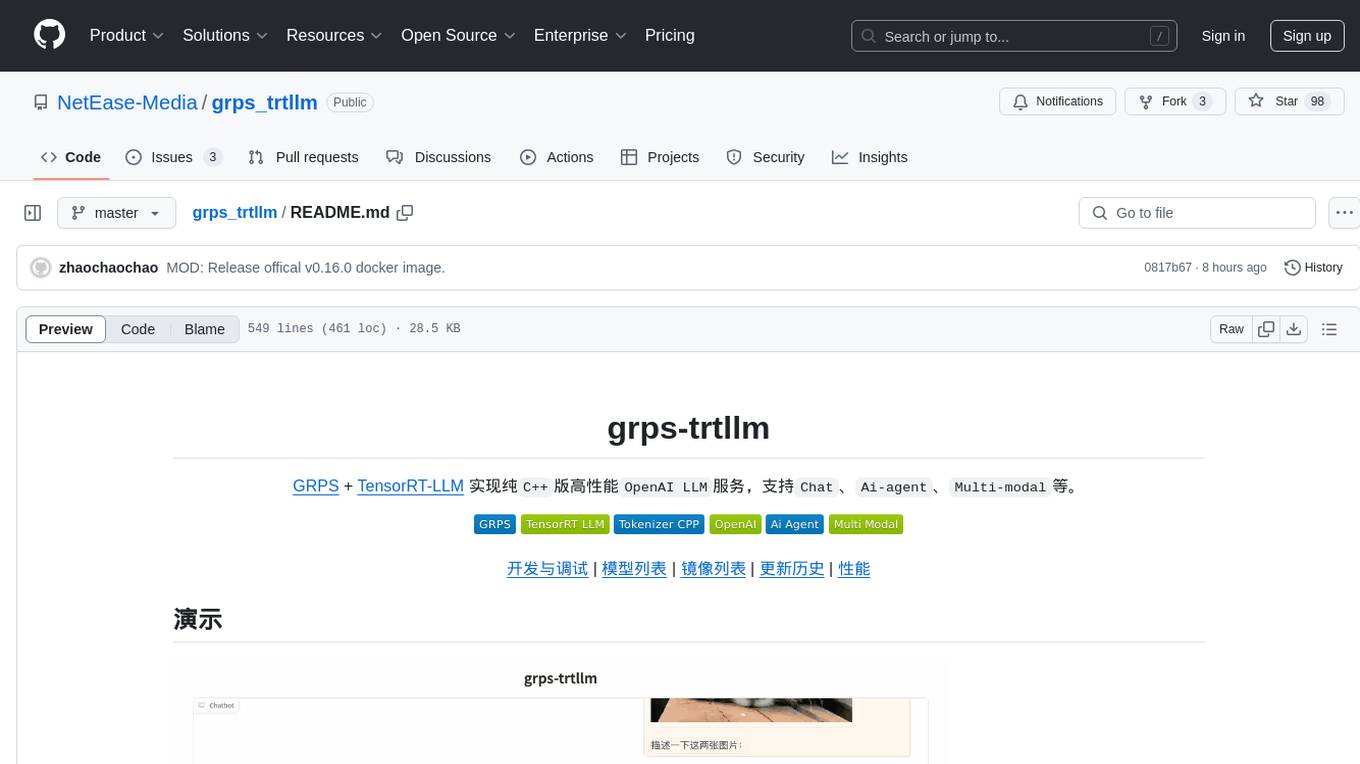
grps_trtllm
The grps-trtllm repository is a C++ implementation of a high-performance OpenAI LLM service, combining GRPS and TensorRT-LLM. It supports functionalities like Chat, Ai-agent, and Multi-modal. The repository offers advantages over triton-trtllm, including a complete LLM service implemented in pure C++, integrated tokenizer supporting huggingface and sentencepiece, custom HTTP functionality for OpenAI interface, support for different LLM prompt styles and result parsing styles, integration with tensorrt backend and opencv library for multi-modal LLM, and stable performance improvement compared to triton-trtllm.
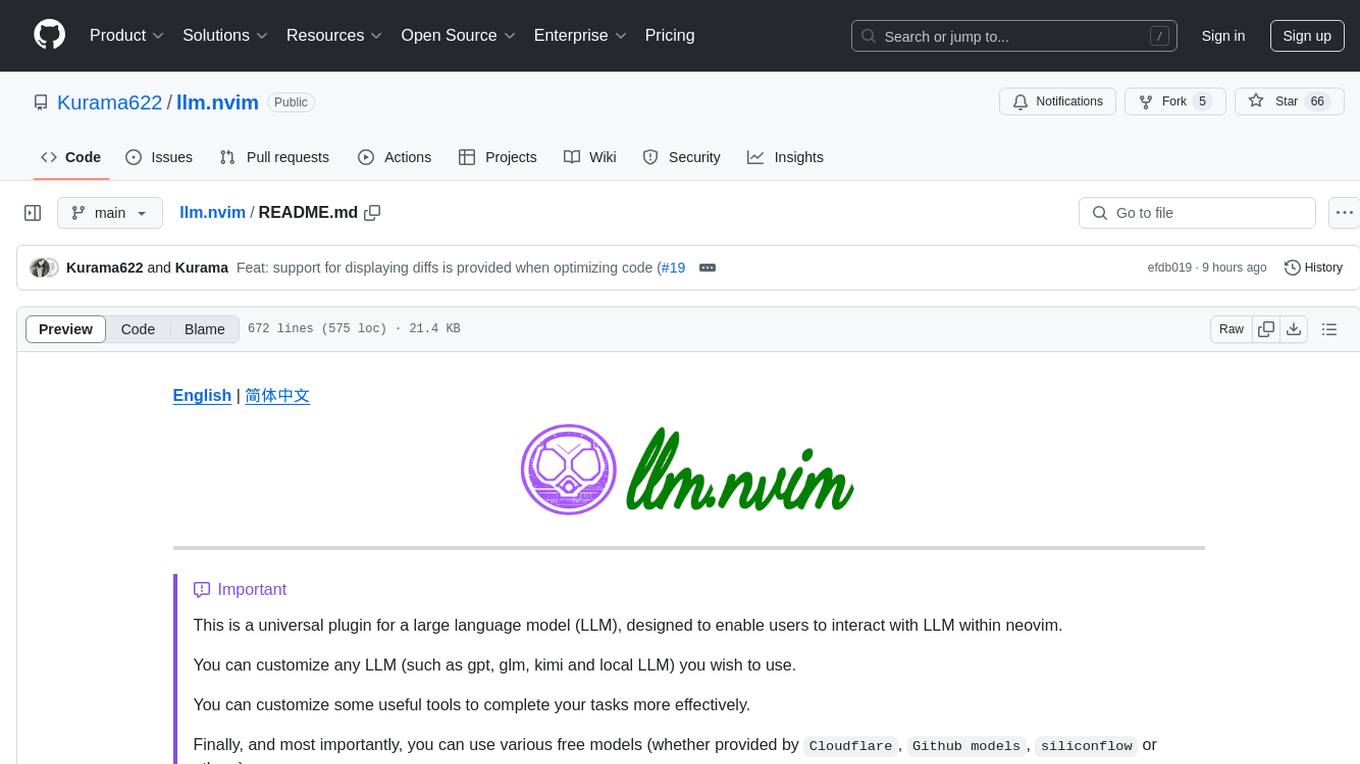
llm.nvim
llm.nvim is a universal plugin for a large language model (LLM) designed to enable users to interact with LLM within neovim. Users can customize various LLMs such as gpt, glm, kimi, and local LLM. The plugin provides tools for optimizing code, comparing code, translating text, and more. It also supports integration with free models from Cloudflare, Github models, siliconflow, and others. Users can customize tools, chat with LLM, quickly translate text, and explain code snippets. The plugin offers a flexible window interface for easy interaction and customization.
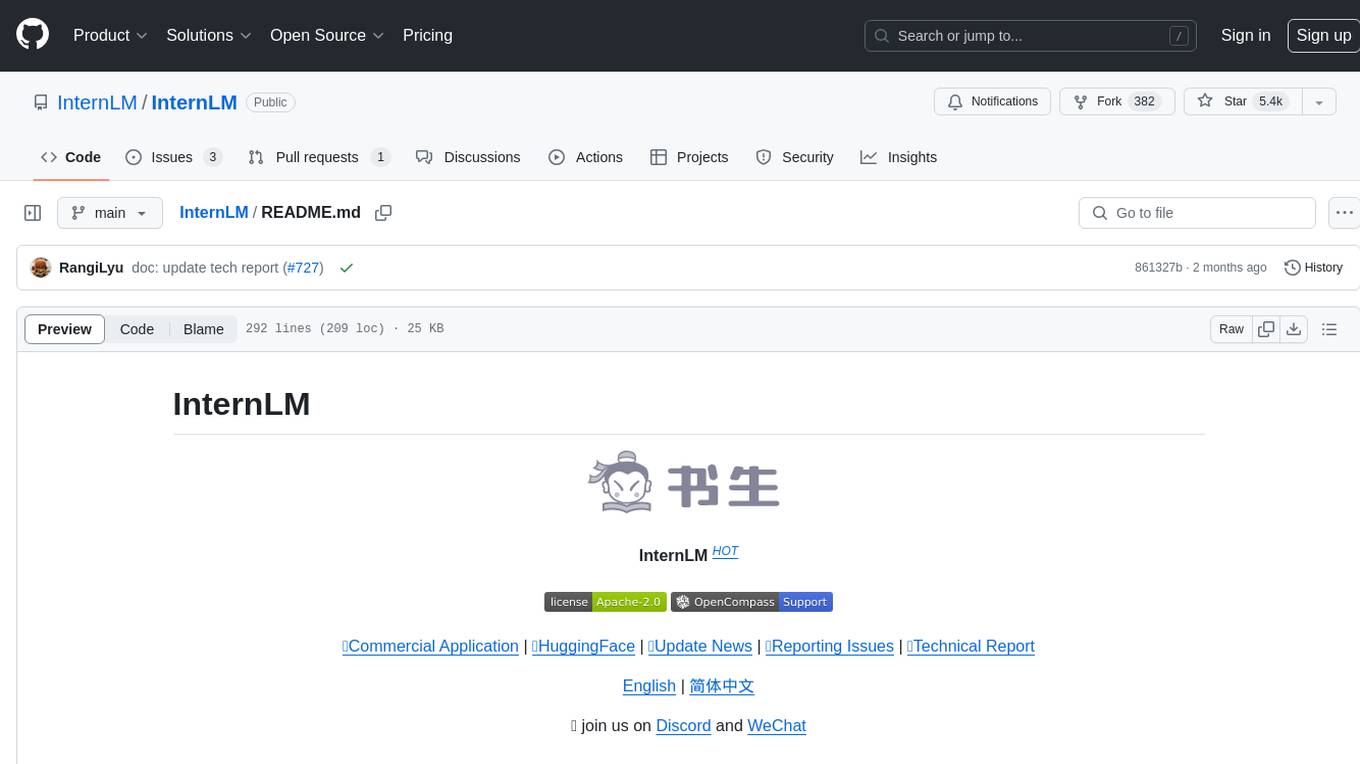
InternLM
InternLM is a powerful language model series with features such as 200K context window for long-context tasks, outstanding comprehensive performance in reasoning, math, code, chat experience, instruction following, and creative writing, code interpreter & data analysis capabilities, and stronger tool utilization capabilities. It offers models in sizes of 7B and 20B, suitable for research and complex scenarios. The models are recommended for various applications and exhibit better performance than previous generations. InternLM models may match or surpass other open-source models like ChatGPT. The tool has been evaluated on various datasets and has shown superior performance in multiple tasks. It requires Python >= 3.8, PyTorch >= 1.12.0, and Transformers >= 4.34 for usage. InternLM can be used for tasks like chat, agent applications, fine-tuning, deployment, and long-context inference.
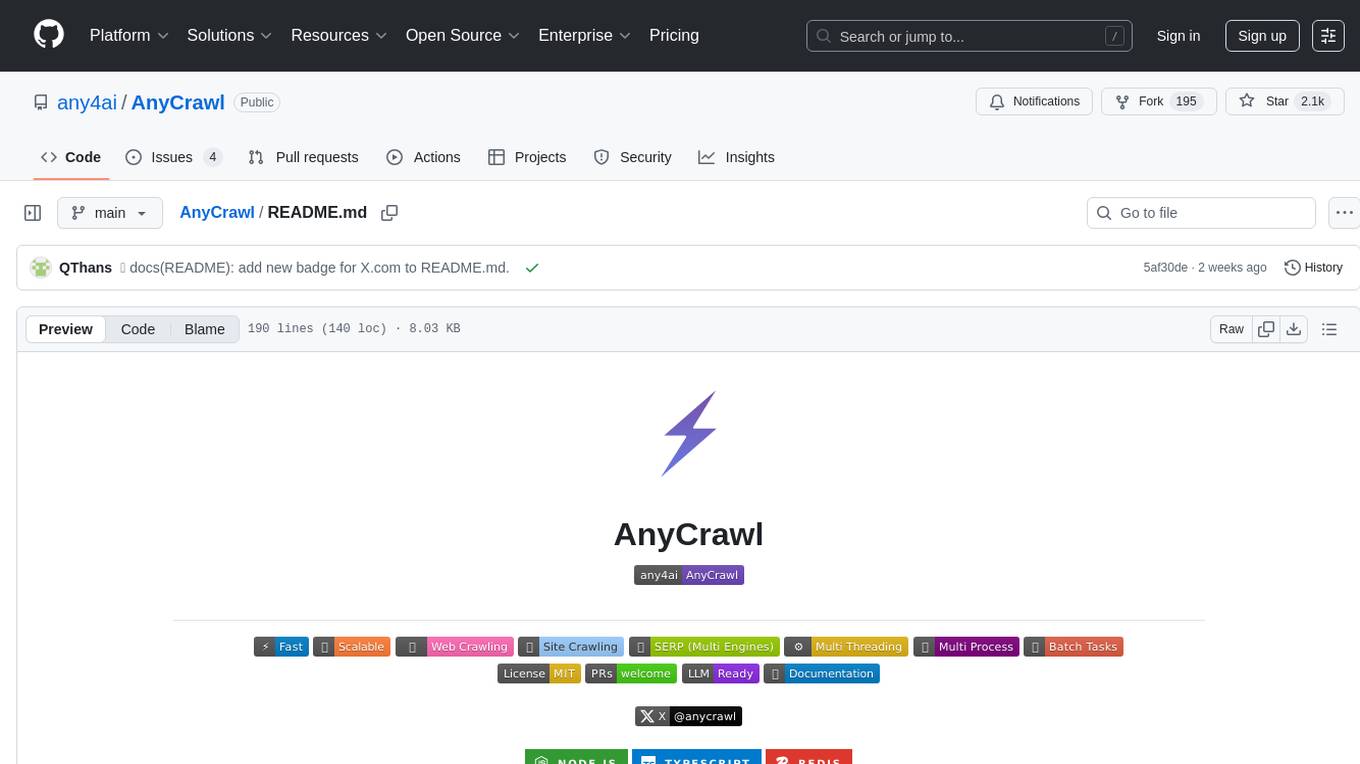
AnyCrawl
AnyCrawl is a high-performance crawling and scraping toolkit designed for SERP crawling, web scraping, site crawling, and batch tasks. It offers multi-threading and multi-process capabilities for high performance. The tool also provides AI extraction for structured data extraction from pages, making it LLM-friendly and easy to integrate and use.
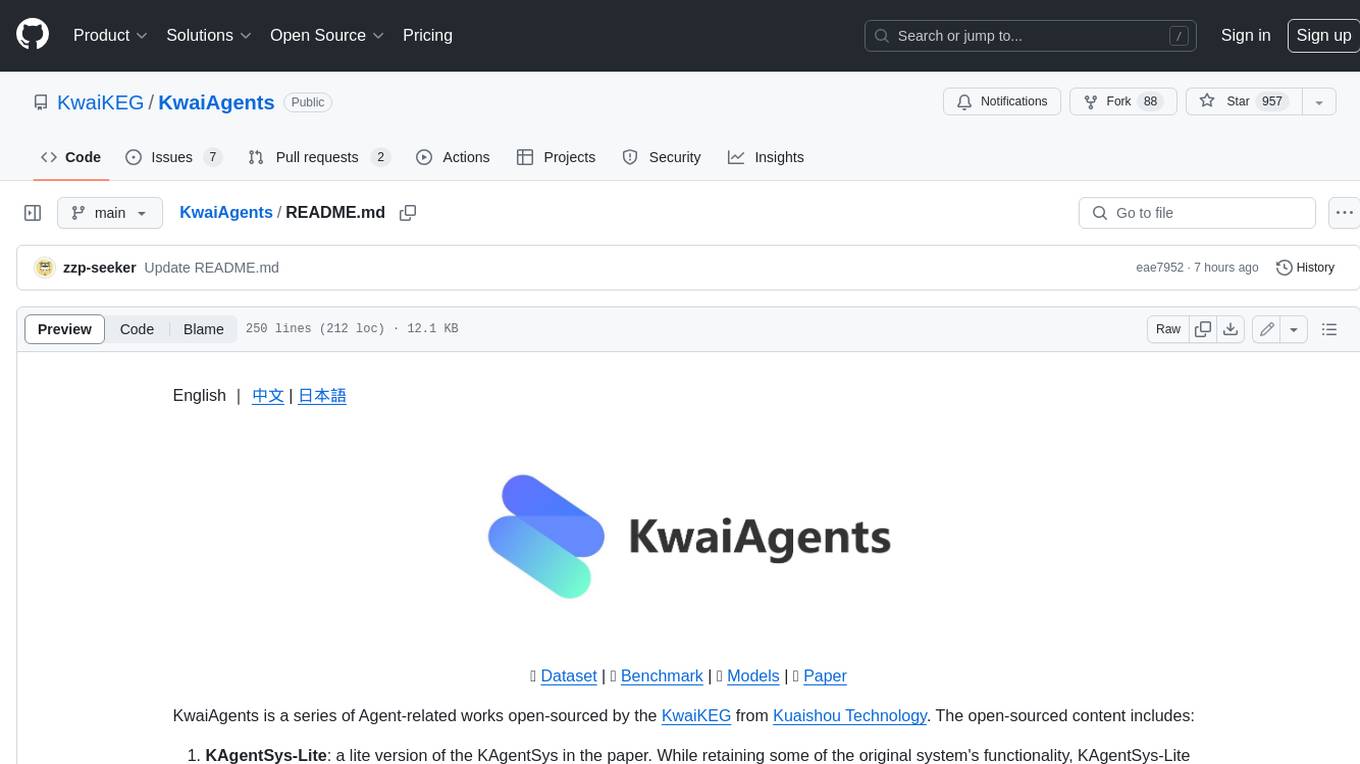
KwaiAgents
KwaiAgents is a series of Agent-related works open-sourced by the [KwaiKEG](https://github.com/KwaiKEG) from [Kuaishou Technology](https://www.kuaishou.com/en). The open-sourced content includes: 1. **KAgentSys-Lite**: a lite version of the KAgentSys in the paper. While retaining some of the original system's functionality, KAgentSys-Lite has certain differences and limitations when compared to its full-featured counterpart, such as: (1) a more limited set of tools; (2) a lack of memory mechanisms; (3) slightly reduced performance capabilities; and (4) a different codebase, as it evolves from open-source projects like BabyAGI and Auto-GPT. Despite these modifications, KAgentSys-Lite still delivers comparable performance among numerous open-source Agent systems available. 2. **KAgentLMs**: a series of large language models with agent capabilities such as planning, reflection, and tool-use, acquired through the Meta-agent tuning proposed in the paper. 3. **KAgentInstruct**: over 200k Agent-related instructions finetuning data (partially human-edited) proposed in the paper. 4. **KAgentBench**: over 3,000 human-edited, automated evaluation data for testing Agent capabilities, with evaluation dimensions including planning, tool-use, reflection, concluding, and profiling.
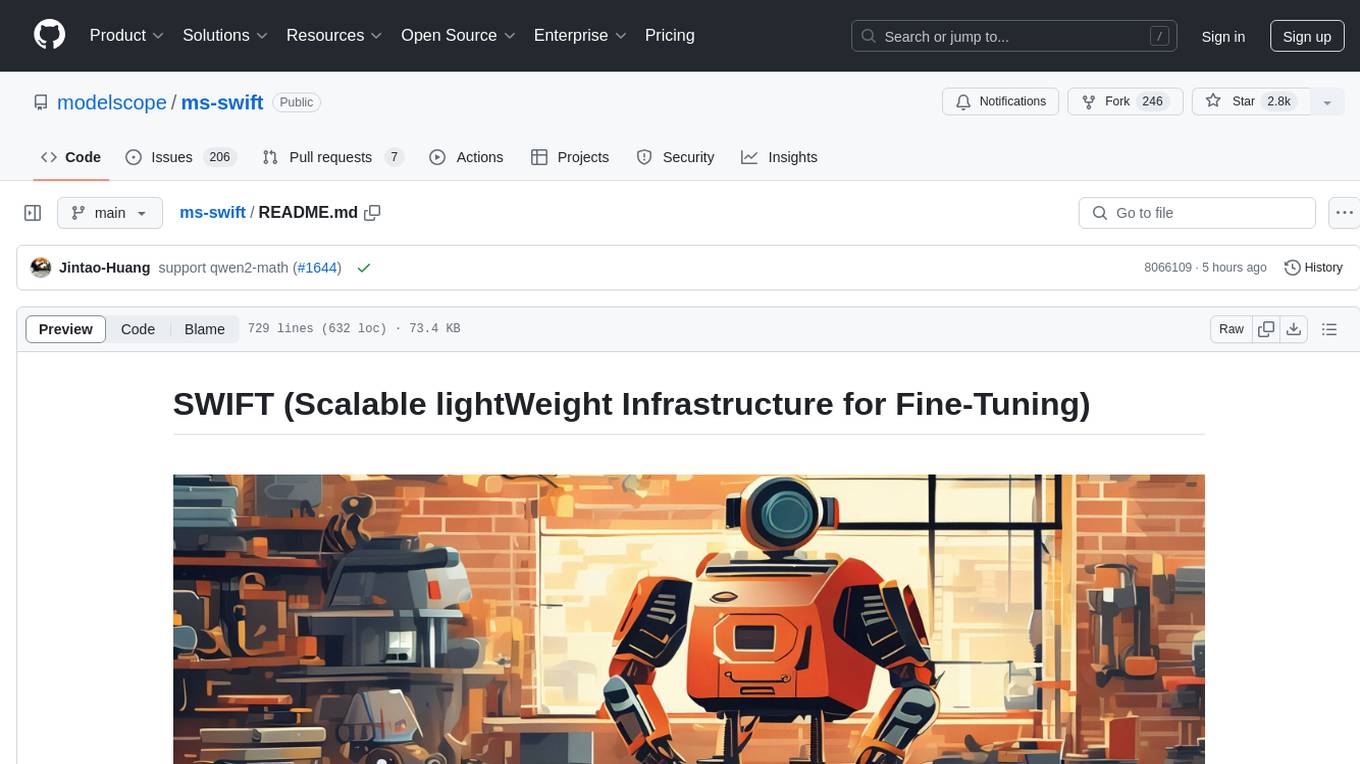
ms-swift
ms-swift is an official framework provided by the ModelScope community for fine-tuning and deploying large language models and multi-modal large models. It supports training, inference, evaluation, quantization, and deployment of over 400 large models and 100+ multi-modal large models. The framework includes various training technologies and accelerates inference, evaluation, and deployment modules. It offers a Gradio-based Web-UI interface and best practices for easy application of large models. ms-swift supports a wide range of model types, dataset types, hardware support, lightweight training methods, distributed training techniques, quantization training, RLHF training, multi-modal training, interface training, plugin and extension support, inference acceleration engines, model evaluation, and model quantization.
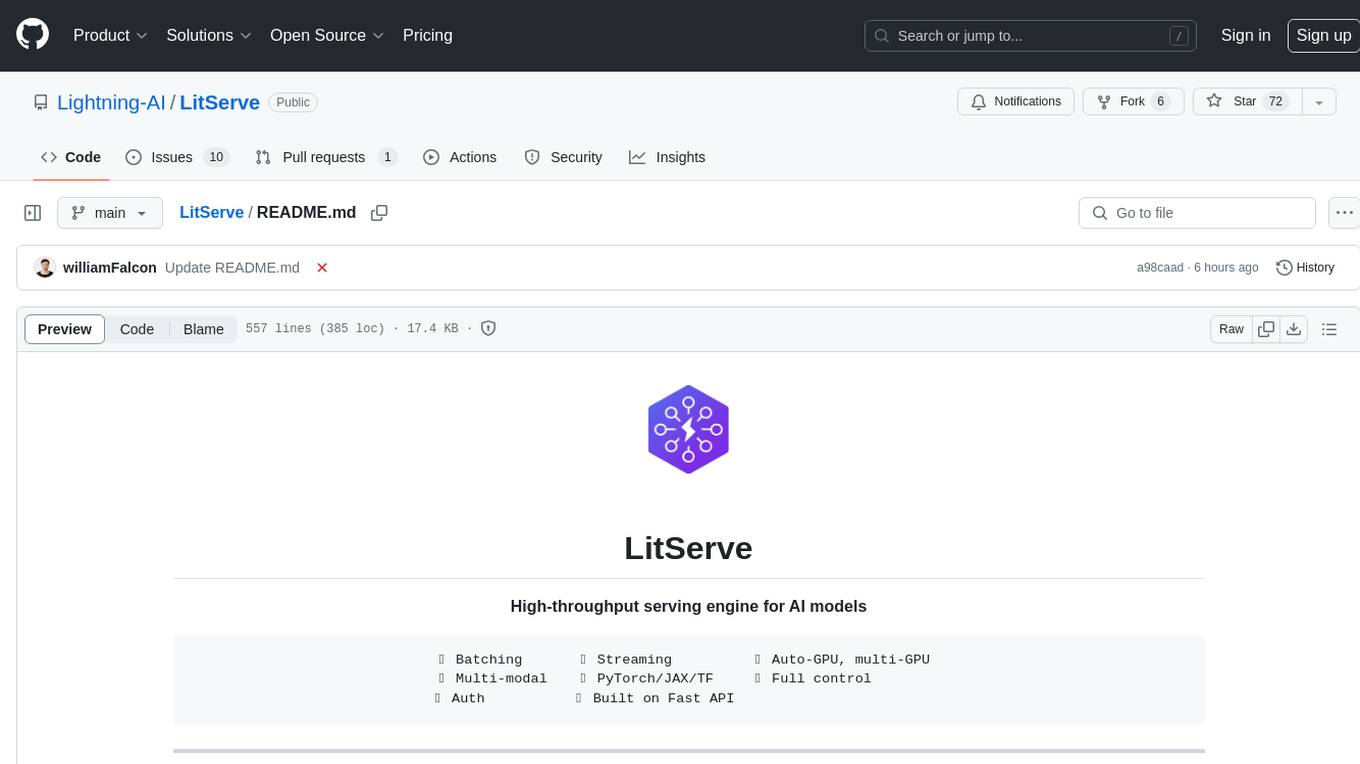
LitServe
LitServe is a high-throughput serving engine designed for deploying AI models at scale. It generates an API endpoint for models, handles batching, streaming, and autoscaling across CPU/GPUs. LitServe is built for enterprise scale with a focus on minimal, hackable code-base without bloat. It supports various model types like LLMs, vision, time-series, and works with frameworks like PyTorch, JAX, Tensorflow, and more. The tool allows users to focus on model performance rather than serving boilerplate, providing full control and flexibility.
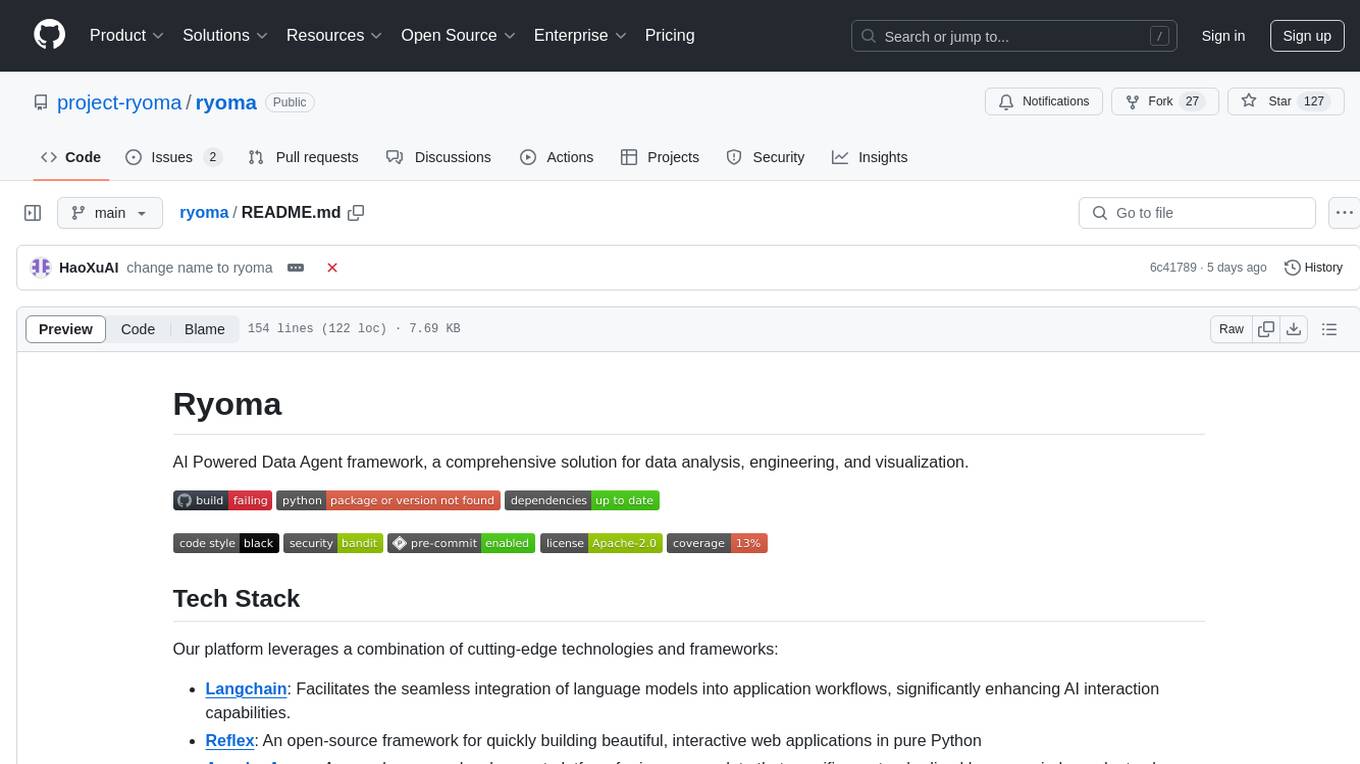
ryoma
Ryoma is an AI Powered Data Agent framework that offers a comprehensive solution for data analysis, engineering, and visualization. It leverages cutting-edge technologies like Langchain, Reflex, Apache Arrow, Jupyter Ai Magics, Amundsen, Ibis, and Feast to provide seamless integration of language models, build interactive web applications, handle in-memory data efficiently, work with AI models, and manage machine learning features in production. Ryoma also supports various data sources like Snowflake, Sqlite, BigQuery, Postgres, MySQL, and different engines like Apache Spark and Apache Flink. The tool enables users to connect to databases, run SQL queries, and interact with data and AI models through a user-friendly UI called Ryoma Lab.
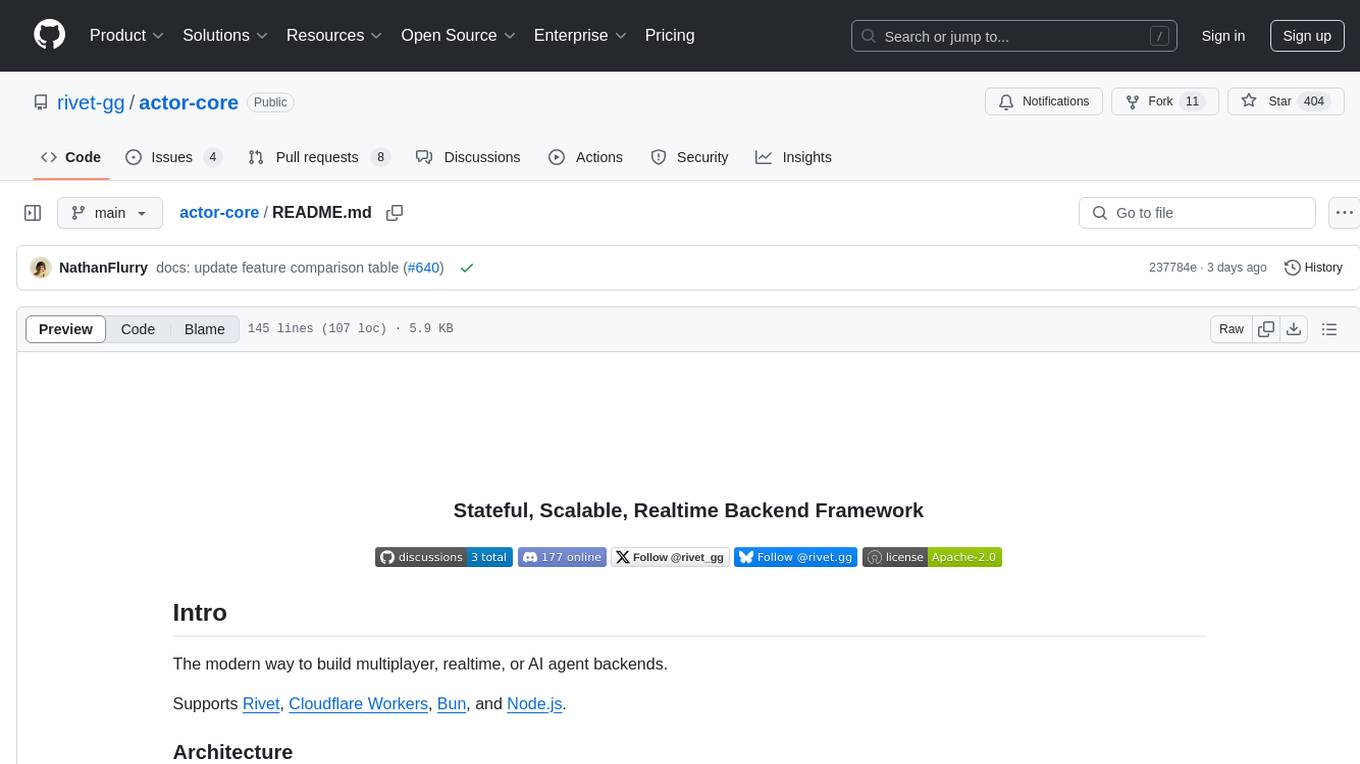
actor-core
Actor-core is a lightweight and flexible library for building actor-based concurrent applications in Java. It provides a simple API for creating and managing actors, as well as handling message passing between actors. With actor-core, developers can easily implement scalable and fault-tolerant systems using the actor model.
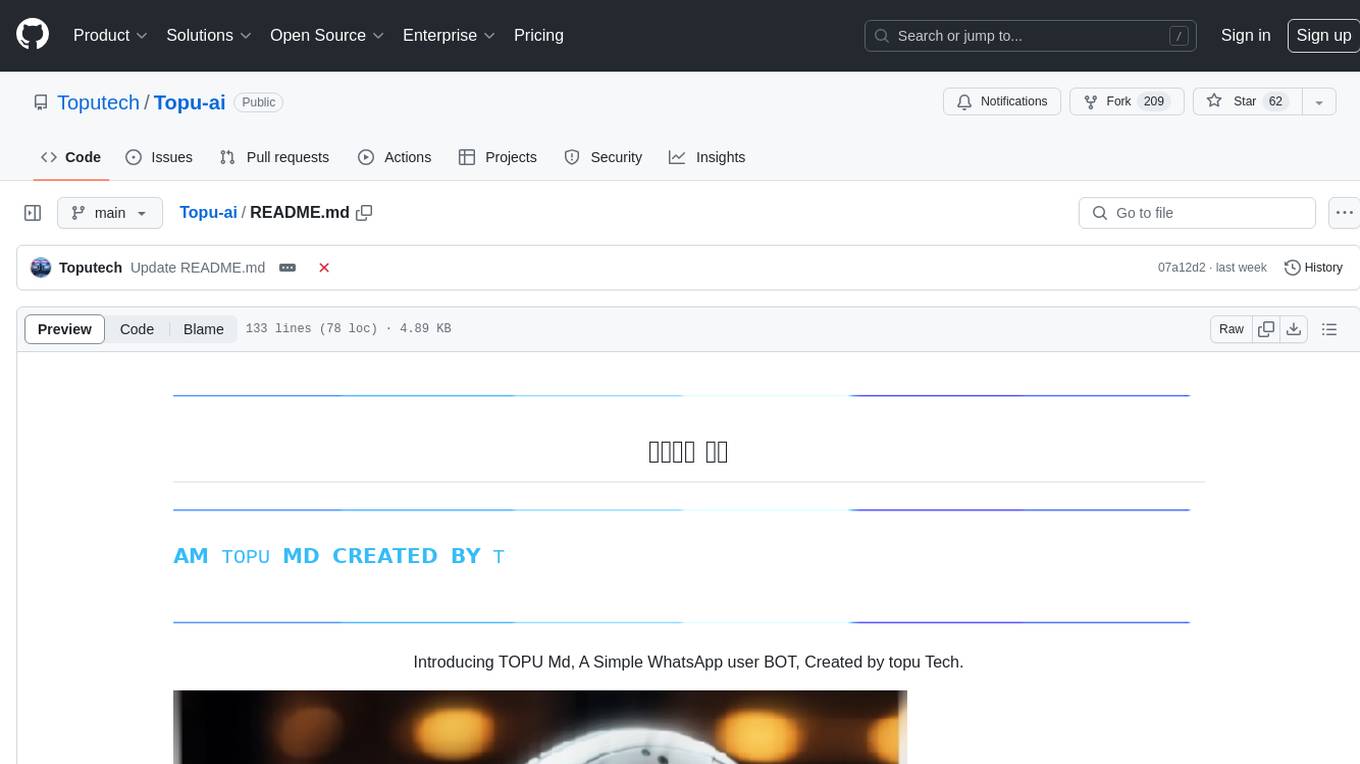
Topu-ai
TOPU Md is a simple WhatsApp user bot created by Topu Tech. It offers various features such as multi-device support, AI photo enhancement, downloader commands, hidden NSFW commands, logo commands, anime commands, economy menu, various games, and audio/video editor commands. Users can fork the repo, get a session ID by pairing code, and deploy on Heroku. The bot requires Node version 18.x or higher for optimal performance. Contributions to TOPU-MD are welcome, and the tool is safe for use on WhatsApp and Heroku. The tool is licensed under the MIT License and is designed to enhance the WhatsApp experience with diverse features.
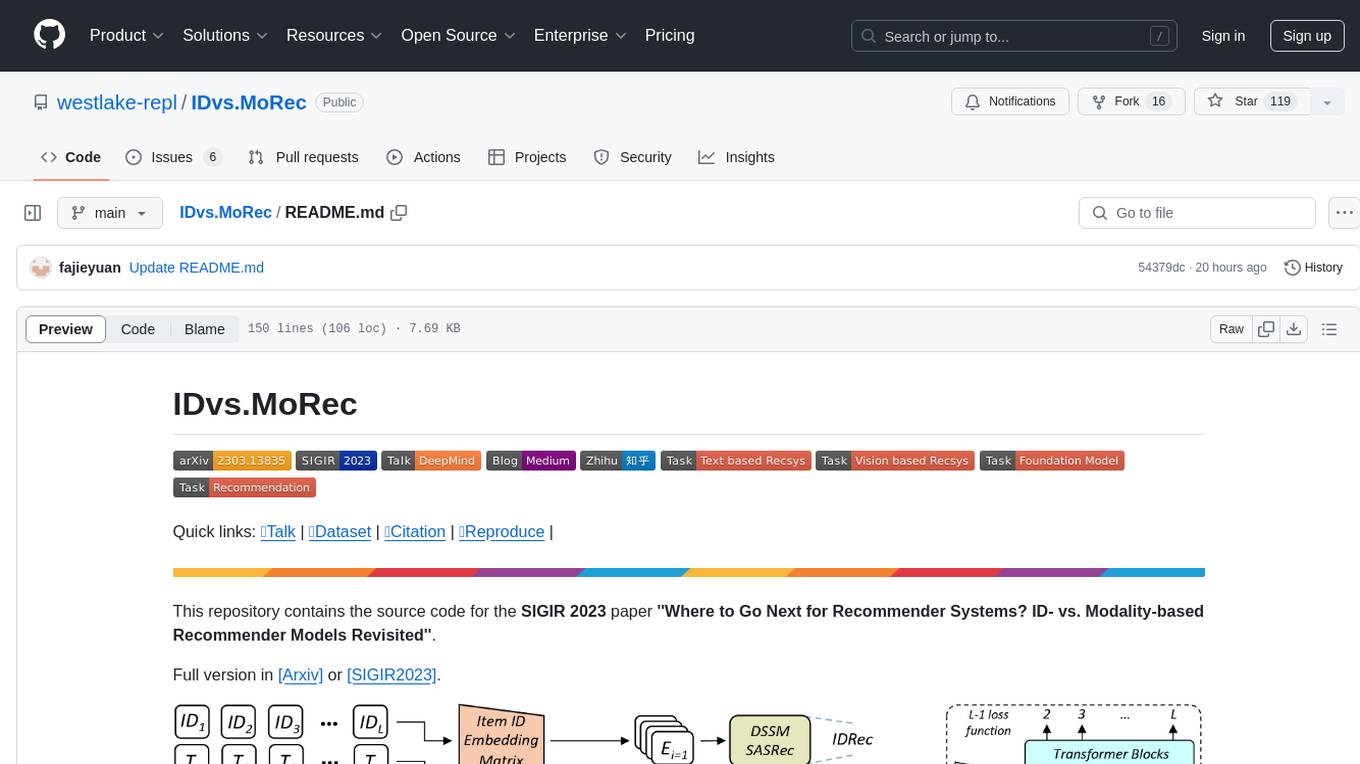
IDvs.MoRec
This repository contains the source code for the SIGIR 2023 paper 'Where to Go Next for Recommender Systems? ID- vs. Modality-based Recommender Models Revisited'. It provides resources for evaluating foundation, transferable, multi-modal, and LLM recommendation models, along with datasets, pre-trained models, and training strategies for IDRec and MoRec using in-batch debiased cross-entropy loss. The repository also offers large-scale datasets, code for SASRec with in-batch debias cross-entropy loss, and information on joining the lab for research opportunities.
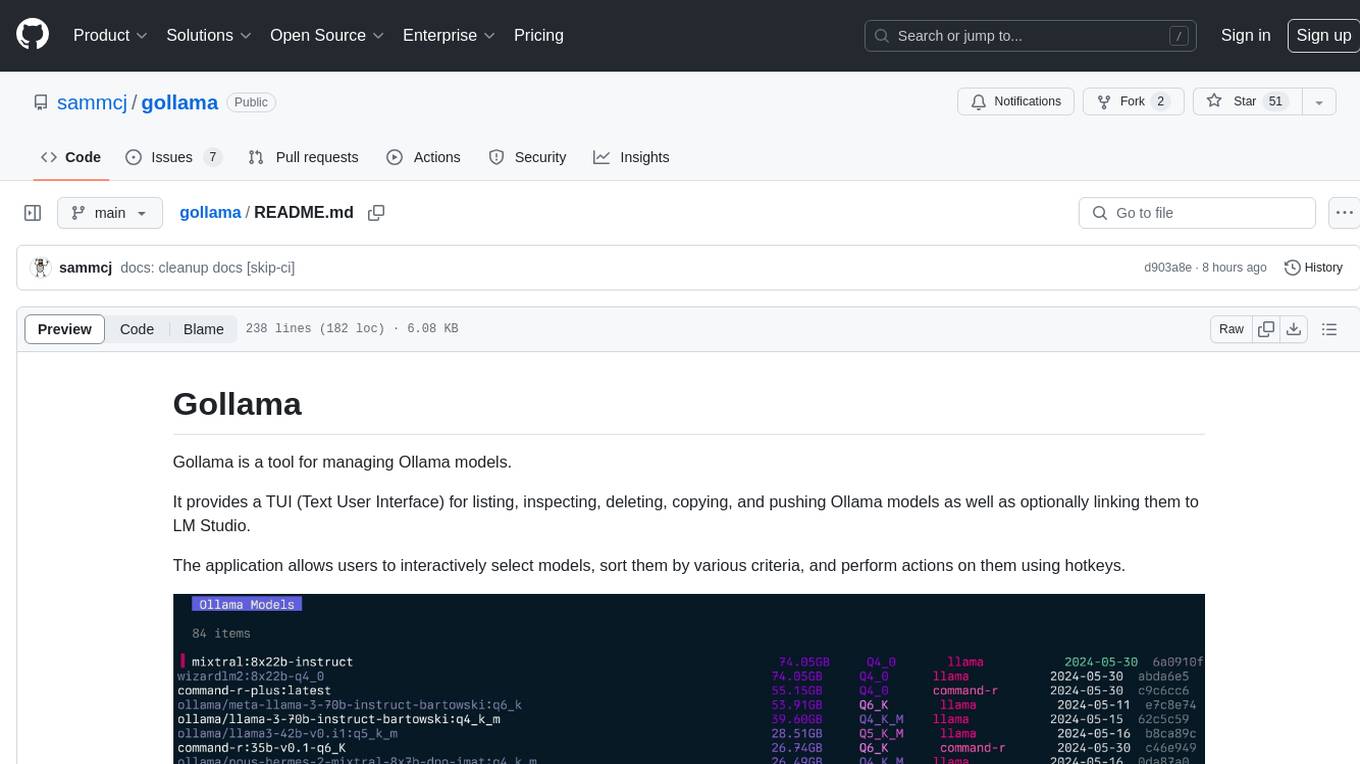
gollama
Gollama is a tool designed for managing Ollama models through a Text User Interface (TUI). Users can list, inspect, delete, copy, and push Ollama models, as well as link them to LM Studio. The application offers interactive model selection, sorting by various criteria, and actions using hotkeys. It provides features like sorting and filtering capabilities, displaying model metadata, model linking, copying, pushing, and more. Gollama aims to be user-friendly and useful for managing models, especially for cleaning up old models.
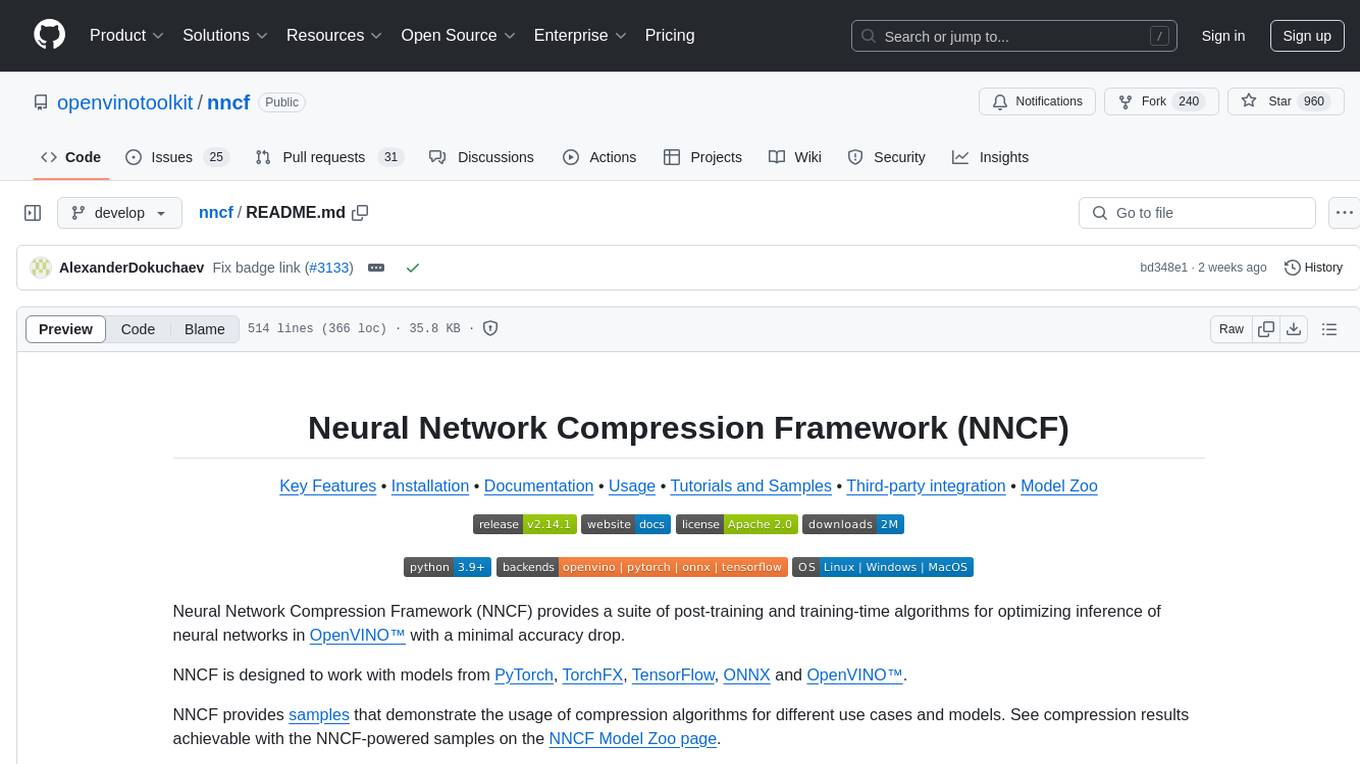
nncf
Neural Network Compression Framework (NNCF) provides a suite of post-training and training-time algorithms for optimizing inference of neural networks in OpenVINO™ with a minimal accuracy drop. It is designed to work with models from PyTorch, TorchFX, TensorFlow, ONNX, and OpenVINO™. NNCF offers samples demonstrating compression algorithms for various use cases and models, with the ability to add different compression algorithms easily. It supports GPU-accelerated layers, distributed training, and seamless combination of pruning, sparsity, and quantization algorithms. NNCF allows exporting compressed models to ONNX or TensorFlow formats for use with OpenVINO™ toolkit, and supports Accuracy-Aware model training pipelines via Adaptive Compression Level Training and Early Exit Training.
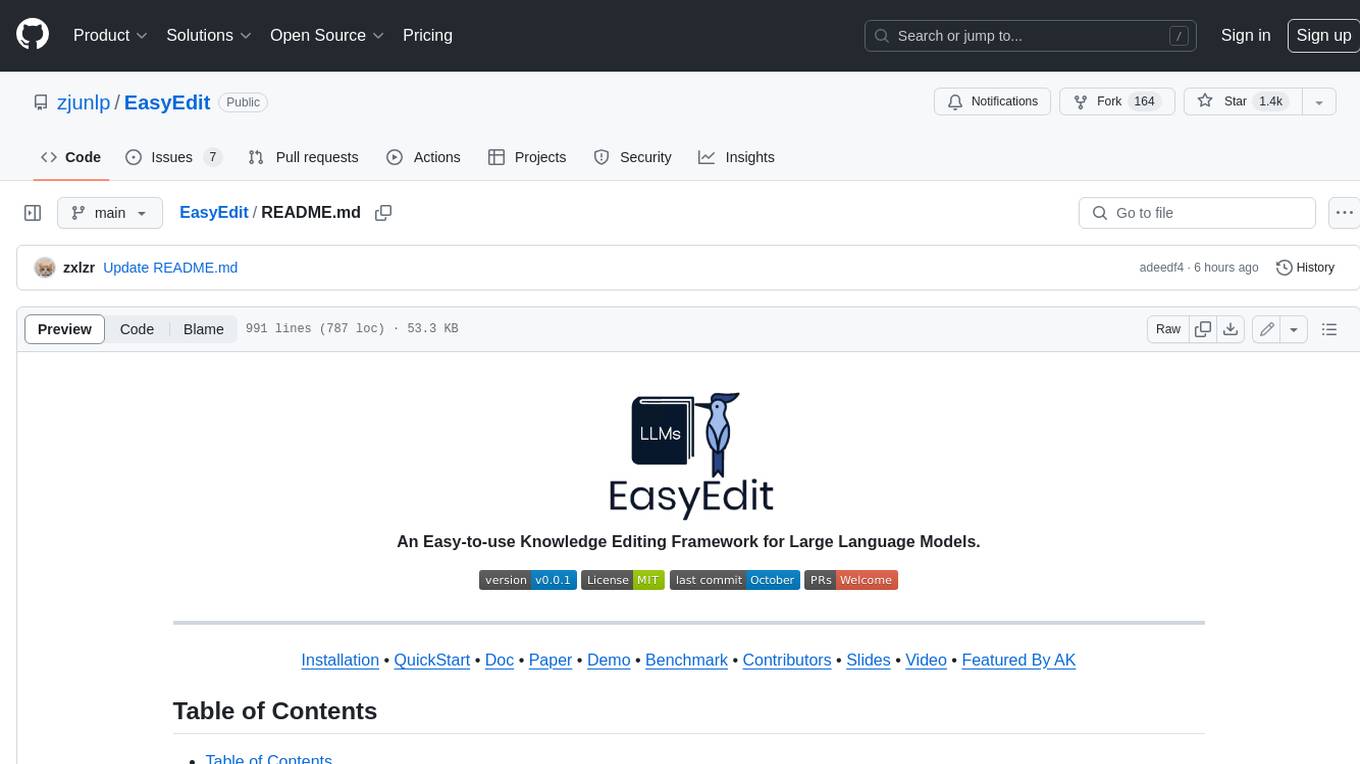
EasyEdit
EasyEdit is a Python package for edit Large Language Models (LLM) like `GPT-J`, `Llama`, `GPT-NEO`, `GPT2`, `T5`(support models from **1B** to **65B**), the objective of which is to alter the behavior of LLMs efficiently within a specific domain without negatively impacting performance across other inputs. It is designed to be easy to use and easy to extend.
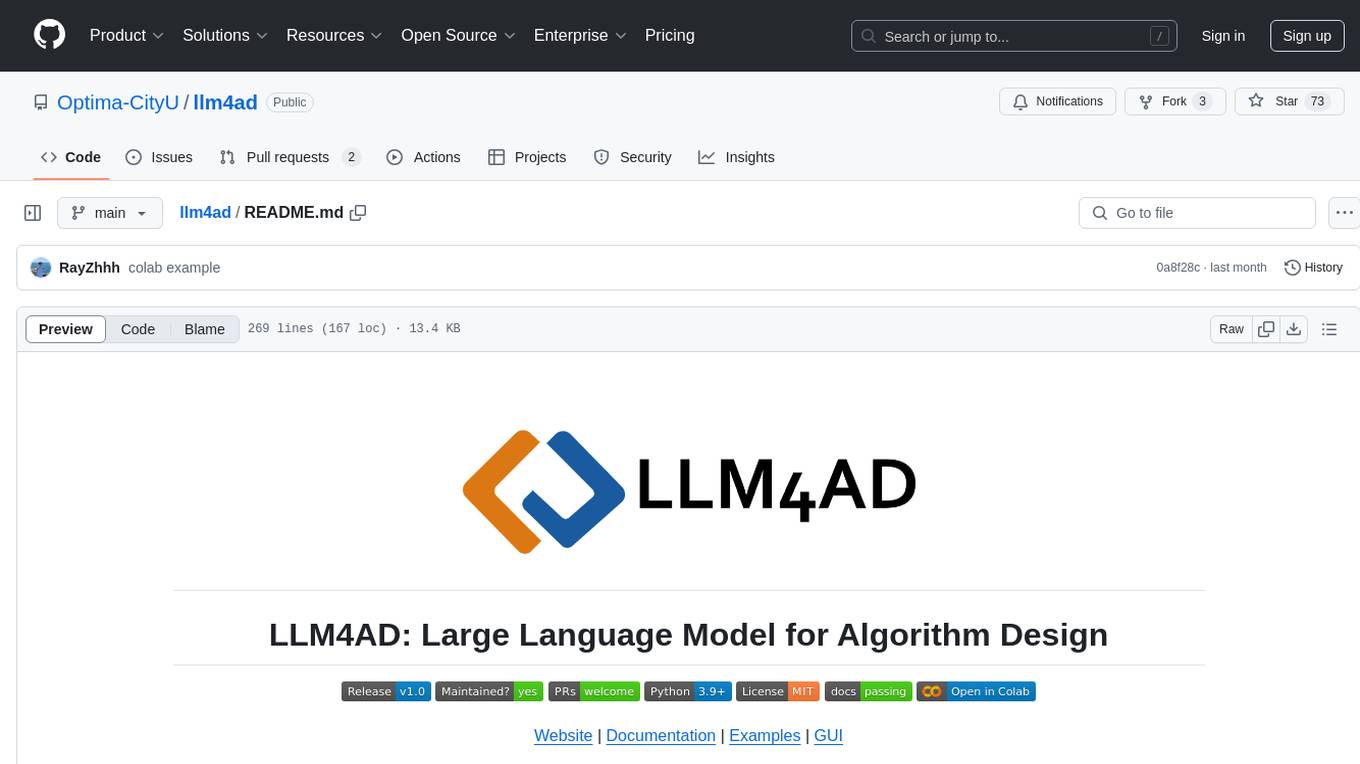
llm4ad
LLM4AD is an open-source Python-based platform leveraging Large Language Models (LLMs) for Automatic Algorithm Design (AD). It provides unified interfaces for methods, tasks, and LLMs, along with features like evaluation acceleration, secure evaluation, logs, GUI support, and more. The platform was originally developed for optimization tasks but is versatile enough to be used in other areas such as machine learning, science discovery, game theory, and engineering design. It offers various search methods and algorithm design tasks across different domains. LLM4AD supports remote LLM API, local HuggingFace LLM deployment, and custom LLM interfaces. The project is licensed under the MIT License and welcomes contributions, collaborations, and issue reports.
For similar tasks
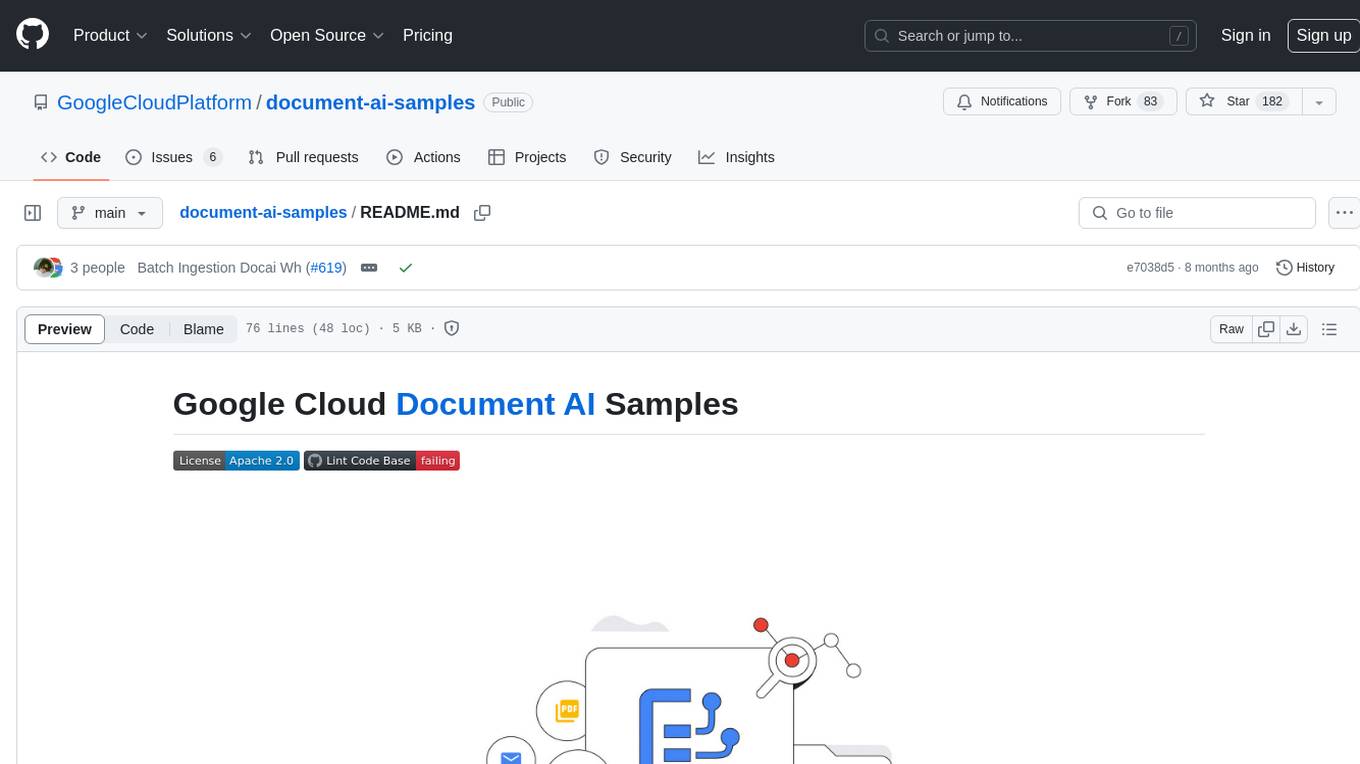
document-ai-samples
The Google Cloud Document AI Samples repository contains code samples and Community Samples demonstrating how to analyze, classify, and search documents using Google Cloud Document AI. It includes various projects showcasing different functionalities such as integrating with Google Drive, processing documents using Python, content moderation with Dialogflow CX, fraud detection, language extraction, paper summarization, tax processing pipeline, and more. The repository also provides access to test document files stored in a publicly-accessible Google Cloud Storage Bucket. Additionally, there are codelabs available for optical character recognition (OCR), form parsing, specialized processors, and managing Document AI processors. Community samples, like the PDF Annotator Sample, are also included. Contributions are welcome, and users can seek help or report issues through the repository's issues page. Please note that this repository is not an officially supported Google product and is intended for demonstrative purposes only.
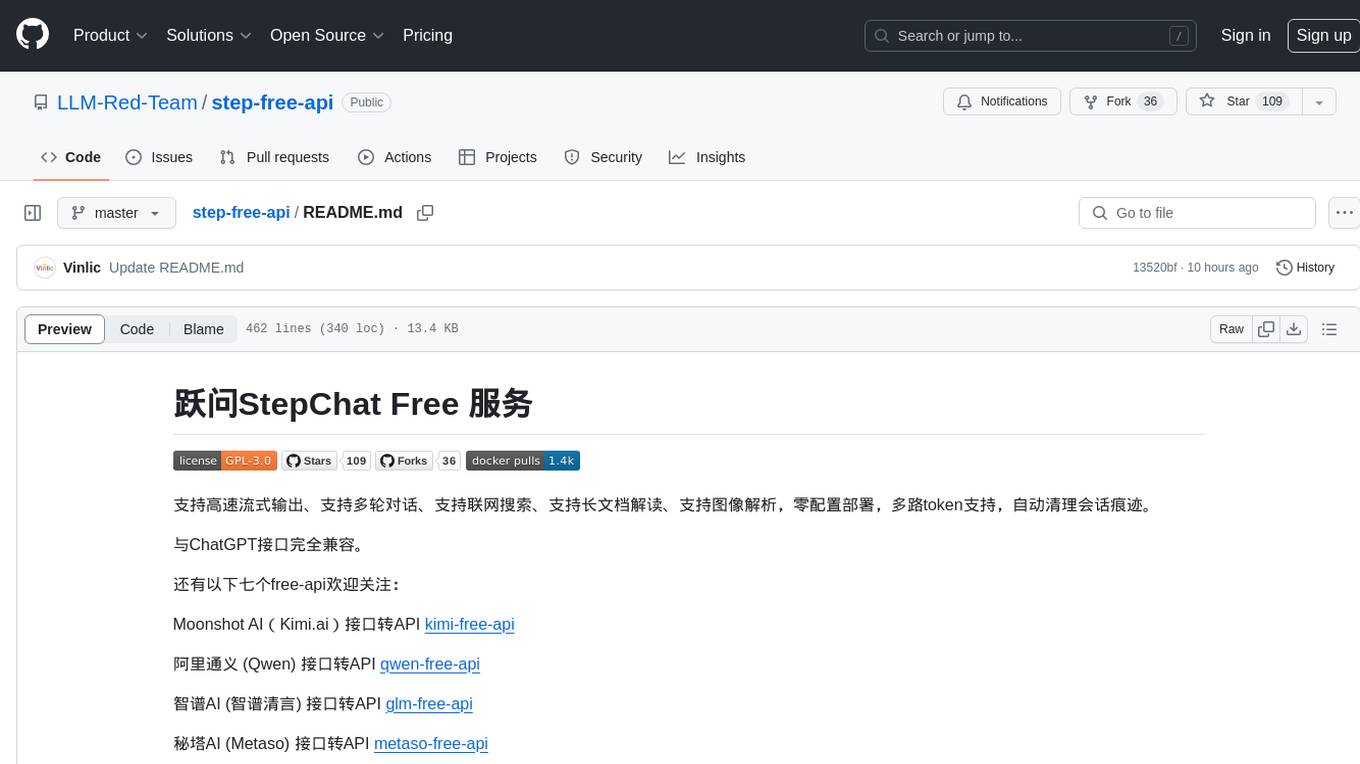
step-free-api
The StepChat Free service provides high-speed streaming output, multi-turn dialogue support, online search support, long document interpretation, and image parsing. It offers zero-configuration deployment, multi-token support, and automatic session trace cleaning. It is fully compatible with the ChatGPT interface. Additionally, it provides seven other free APIs for various services. The repository includes a disclaimer about using reverse APIs and encourages users to avoid commercial use to prevent service pressure on the official platform. It offers online testing links, showcases different demos, and provides deployment guides for Docker, Docker-compose, Render, Vercel, and native deployments. The repository also includes information on using multiple accounts, optimizing Nginx reverse proxy, and checking the liveliness of refresh tokens.
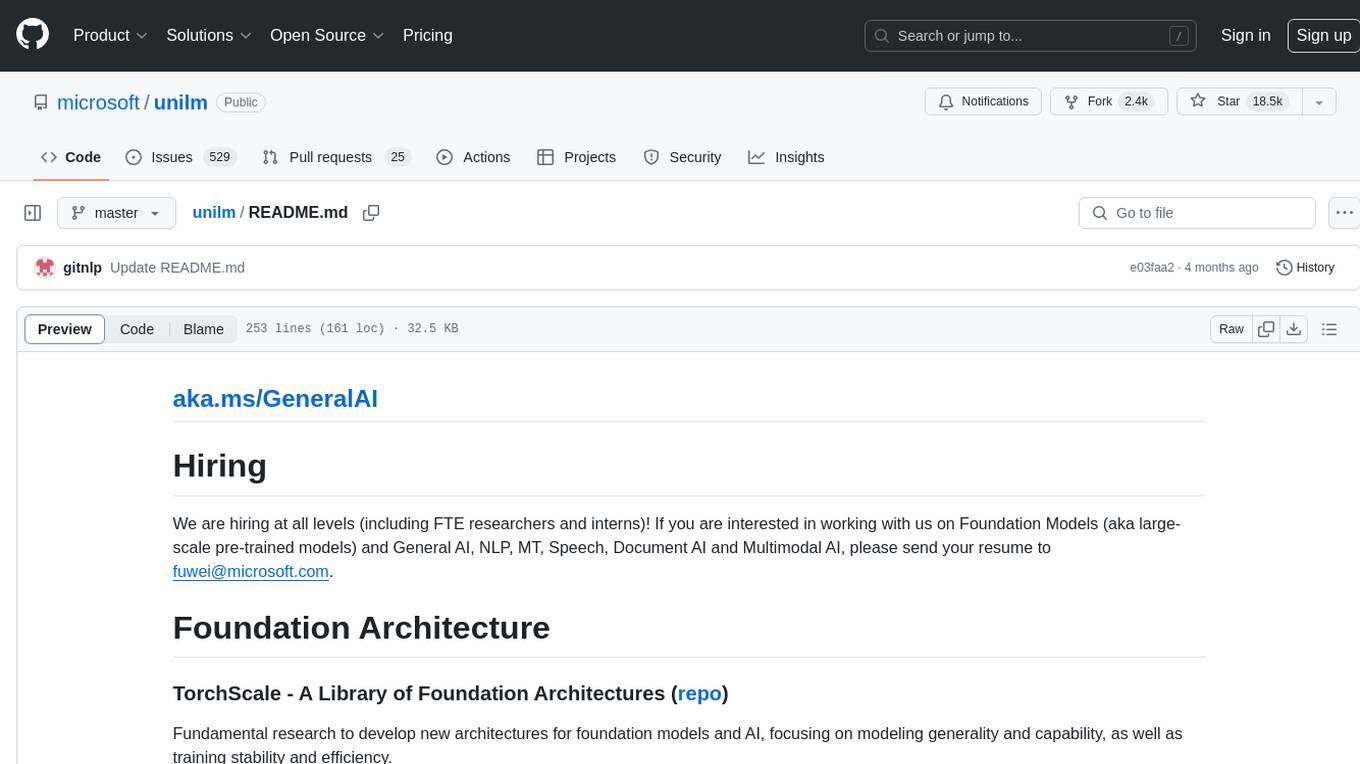
unilm
The 'unilm' repository is a collection of tools, models, and architectures for Foundation Models and General AI, focusing on tasks such as NLP, MT, Speech, Document AI, and Multimodal AI. It includes various pre-trained models, such as UniLM, InfoXLM, DeltaLM, MiniLM, AdaLM, BEiT, LayoutLM, WavLM, VALL-E, and more, designed for tasks like language understanding, generation, translation, vision, speech, and multimodal processing. The repository also features toolkits like s2s-ft for sequence-to-sequence fine-tuning and Aggressive Decoding for efficient sequence-to-sequence decoding. Additionally, it offers applications like TrOCR for OCR, LayoutReader for reading order detection, and XLM-T for multilingual NMT.
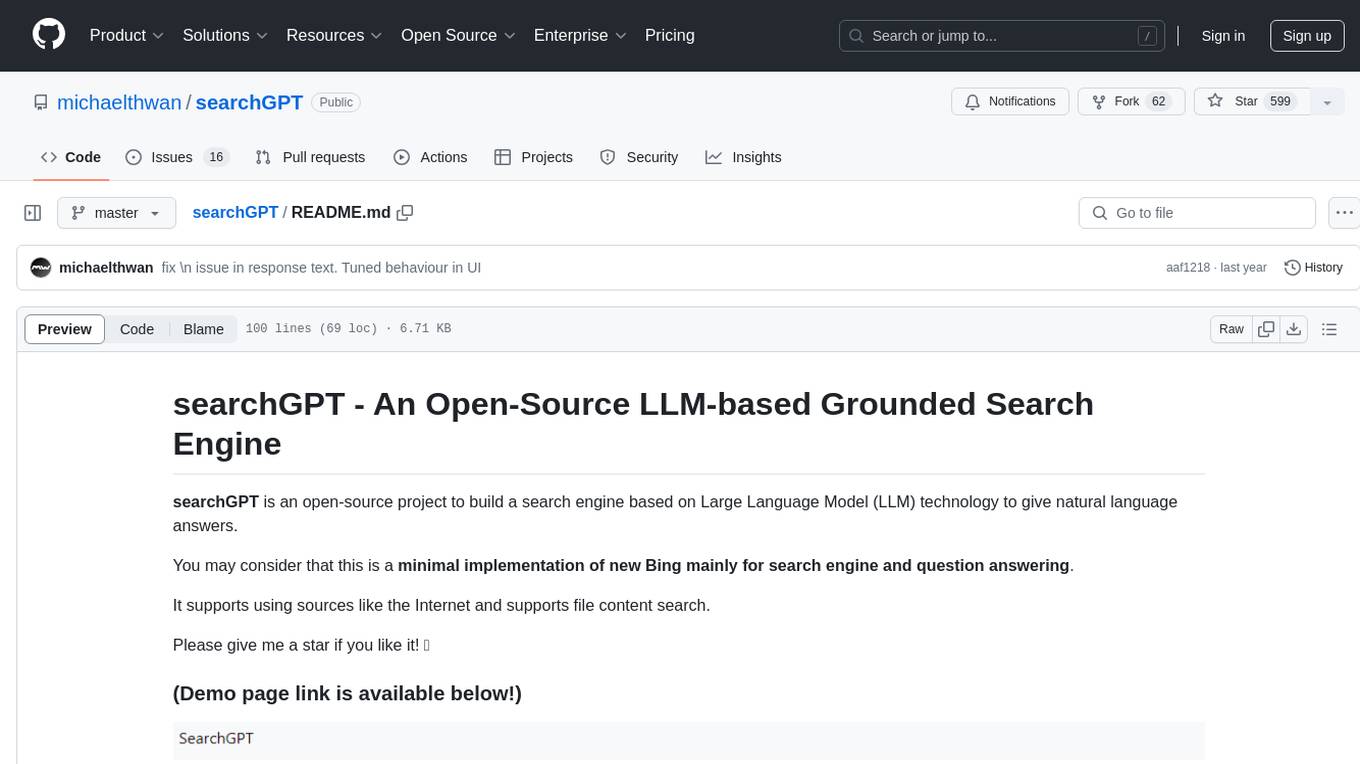
searchGPT
searchGPT is an open-source project that aims to build a search engine based on Large Language Model (LLM) technology to provide natural language answers. It supports web search with real-time results, file content search, and semantic search from sources like the Internet. The tool integrates LLM technologies such as OpenAI and GooseAI, and offers an easy-to-use frontend user interface. The project is designed to provide grounded answers by referencing real-time factual information, addressing the limitations of LLM's training data. Contributions, especially from frontend developers, are welcome under the MIT License.
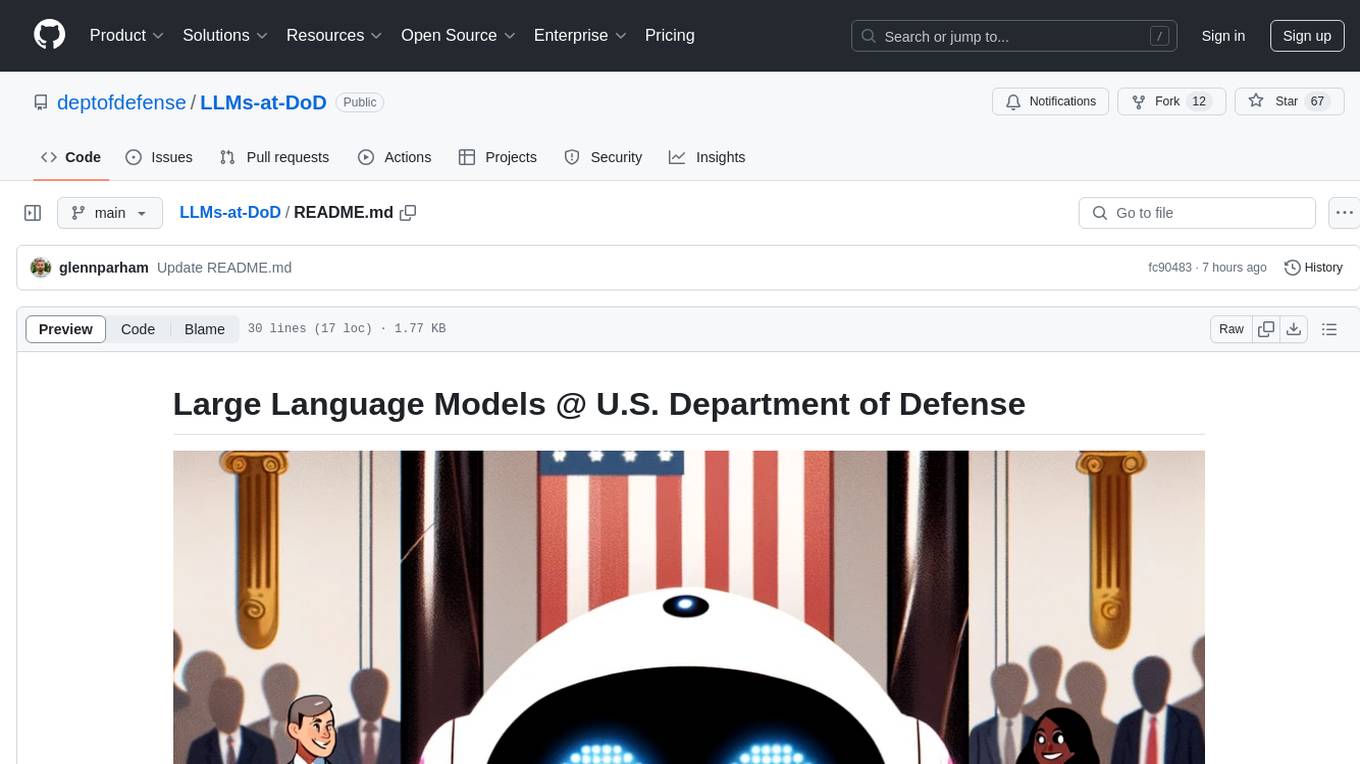
LLMs-at-DoD
This repository contains tutorials for using Large Language Models (LLMs) in the U.S. Department of Defense. The tutorials utilize open-source frameworks and LLMs, allowing users to run them in their own cloud environments. The repository is maintained by the Defense Digital Service and welcomes contributions from users.
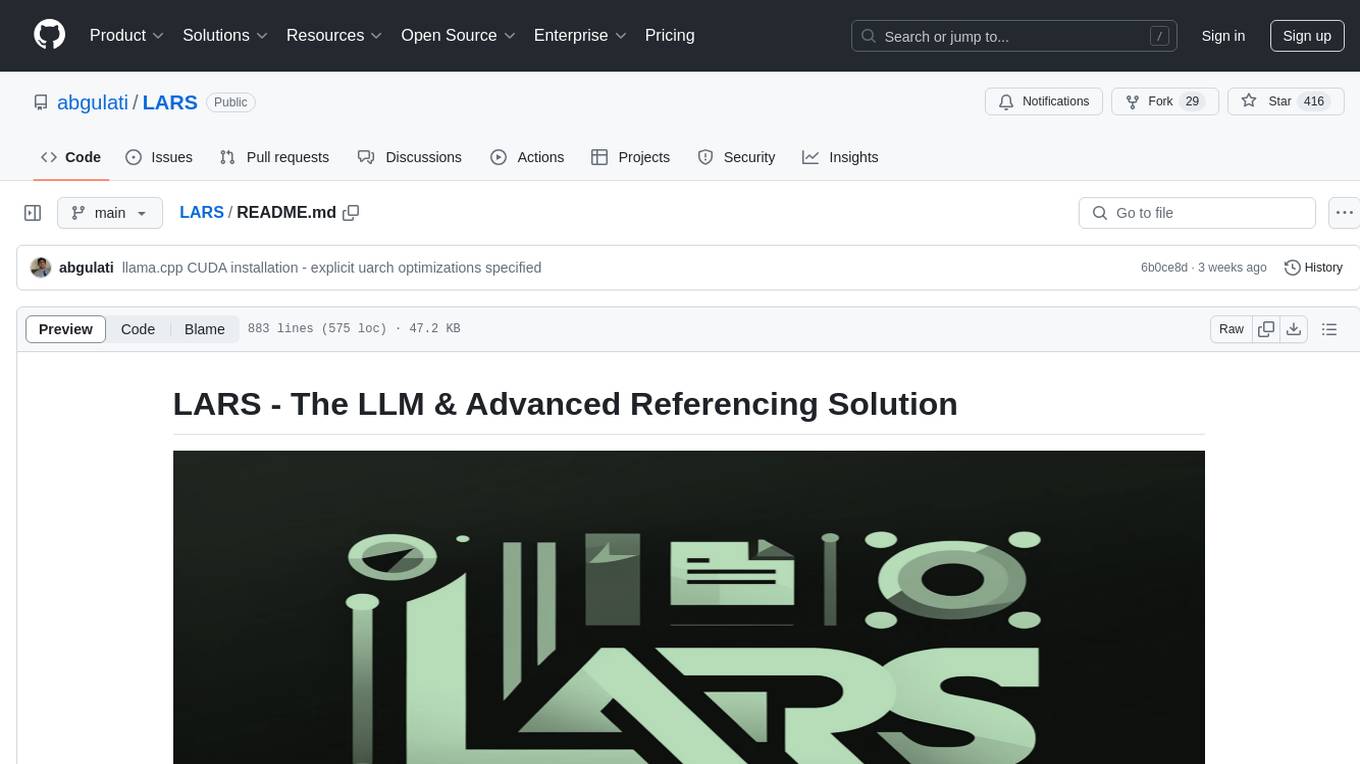
LARS
LARS is an application that enables users to run Large Language Models (LLMs) locally on their devices, upload their own documents, and engage in conversations where the LLM grounds its responses with the uploaded content. The application focuses on Retrieval Augmented Generation (RAG) to increase accuracy and reduce AI-generated inaccuracies. LARS provides advanced citations, supports various file formats, allows follow-up questions, provides full chat history, and offers customization options for LLM settings. Users can force enable or disable RAG, change system prompts, and tweak advanced LLM settings. The application also supports GPU-accelerated inferencing, multiple embedding models, and text extraction methods. LARS is open-source and aims to be the ultimate RAG-centric LLM application.

EAGLE
Eagle is a family of Vision-Centric High-Resolution Multimodal LLMs that enhance multimodal LLM perception using a mix of vision encoders and various input resolutions. The model features a channel-concatenation-based fusion for vision experts with different architectures and knowledge, supporting up to over 1K input resolution. It excels in resolution-sensitive tasks like optical character recognition and document understanding.
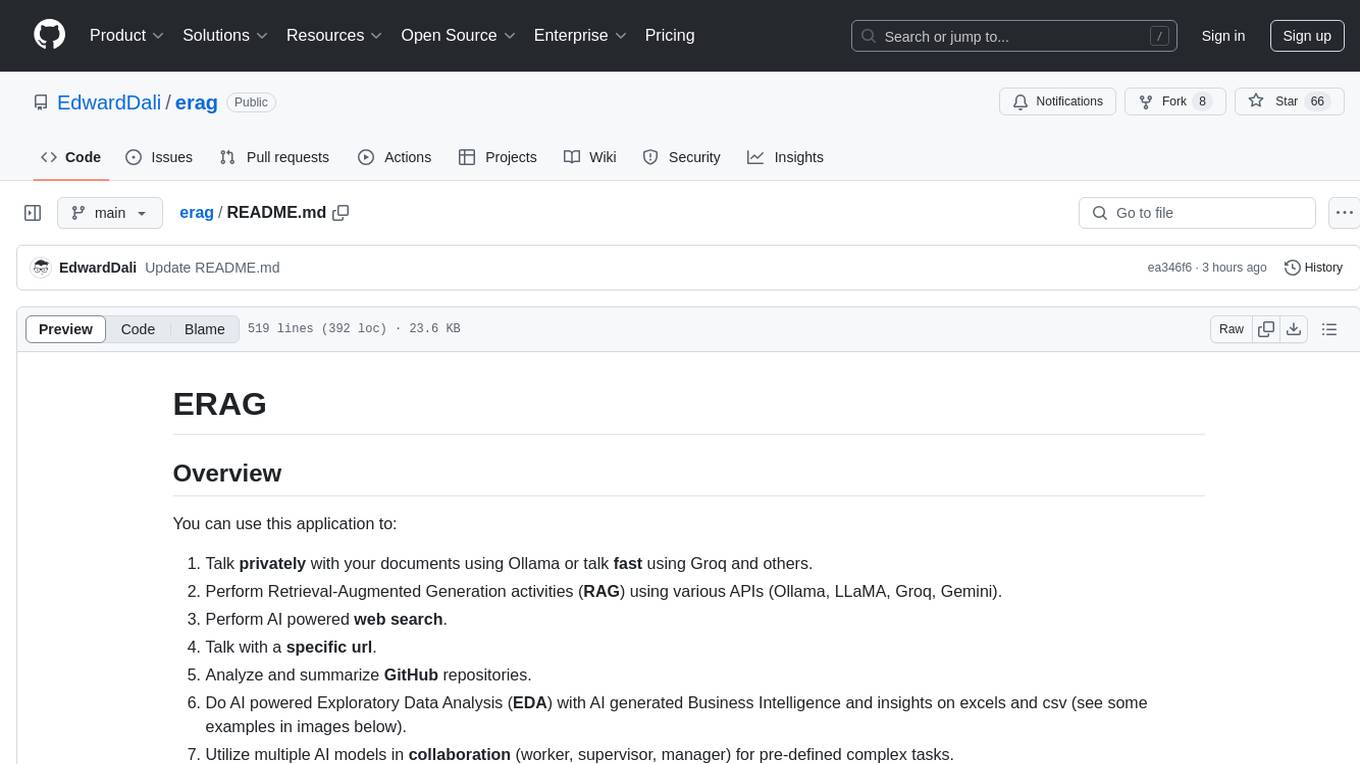
erag
ERAG is an advanced system that combines lexical, semantic, text, and knowledge graph searches with conversation context to provide accurate and contextually relevant responses. This tool processes various document types, creates embeddings, builds knowledge graphs, and uses this information to answer user queries intelligently. It includes modules for interacting with web content, GitHub repositories, and performing exploratory data analysis using various language models.
For similar jobs

weave
Weave is a toolkit for developing Generative AI applications, built by Weights & Biases. With Weave, you can log and debug language model inputs, outputs, and traces; build rigorous, apples-to-apples evaluations for language model use cases; and organize all the information generated across the LLM workflow, from experimentation to evaluations to production. Weave aims to bring rigor, best-practices, and composability to the inherently experimental process of developing Generative AI software, without introducing cognitive overhead.

LLMStack
LLMStack is a no-code platform for building generative AI agents, workflows, and chatbots. It allows users to connect their own data, internal tools, and GPT-powered models without any coding experience. LLMStack can be deployed to the cloud or on-premise and can be accessed via HTTP API or triggered from Slack or Discord.

VisionCraft
The VisionCraft API is a free API for using over 100 different AI models. From images to sound.

kaito
Kaito is an operator that automates the AI/ML inference model deployment in a Kubernetes cluster. It manages large model files using container images, avoids tuning deployment parameters to fit GPU hardware by providing preset configurations, auto-provisions GPU nodes based on model requirements, and hosts large model images in the public Microsoft Container Registry (MCR) if the license allows. Using Kaito, the workflow of onboarding large AI inference models in Kubernetes is largely simplified.

PyRIT
PyRIT is an open access automation framework designed to empower security professionals and ML engineers to red team foundation models and their applications. It automates AI Red Teaming tasks to allow operators to focus on more complicated and time-consuming tasks and can also identify security harms such as misuse (e.g., malware generation, jailbreaking), and privacy harms (e.g., identity theft). The goal is to allow researchers to have a baseline of how well their model and entire inference pipeline is doing against different harm categories and to be able to compare that baseline to future iterations of their model. This allows them to have empirical data on how well their model is doing today, and detect any degradation of performance based on future improvements.

tabby
Tabby is a self-hosted AI coding assistant, offering an open-source and on-premises alternative to GitHub Copilot. It boasts several key features: * Self-contained, with no need for a DBMS or cloud service. * OpenAPI interface, easy to integrate with existing infrastructure (e.g Cloud IDE). * Supports consumer-grade GPUs.

spear
SPEAR (Simulator for Photorealistic Embodied AI Research) is a powerful tool for training embodied agents. It features 300 unique virtual indoor environments with 2,566 unique rooms and 17,234 unique objects that can be manipulated individually. Each environment is designed by a professional artist and features detailed geometry, photorealistic materials, and a unique floor plan and object layout. SPEAR is implemented as Unreal Engine assets and provides an OpenAI Gym interface for interacting with the environments via Python.

Magick
Magick is a groundbreaking visual AIDE (Artificial Intelligence Development Environment) for no-code data pipelines and multimodal agents. Magick can connect to other services and comes with nodes and templates well-suited for intelligent agents, chatbots, complex reasoning systems and realistic characters.


